The Department of Internal Affairs
Te Tari Taiwhenua
Appendix B: Penultimate draft Cabinet paper with alternative financial
recommendations
This is an alternate version of the final cabinet paper which would seek a year-on-year
appropriation over a multi-year appropriation. We are currently seeking advice from the
Treasury on which appropriation to use.
ACT
N
NFOR
INFORMATION
FI
OFFICIAL
R
RELEASED U
RELEASED UNDER THE
IN-CONFIDENCE
Page 10 of 19
The Department of Internal Affairs
Te Tari Taiwhenua
Appendix C: Regulatory Impact Statement
ACT
N
NFOR
INFORMATION
FI
OFFICIAL
R
RELEASED U
RELEASED UNDER THE
IN-CONFIDENCE
Page 11 of 19
The Department of Internal Affairs
Te Tari Taiwhenua
Appendix D: Current infringement offences and penalties under Schedule 1 of the
Dog Control Act 1996
Section
Brief description of offence
Infringement fee ($)
18
Wilful obstruction of dog control officer or ranger
750
19(2)
Failure or refusal to supply information or wilfully providing
false particulars
750
19A(2)
Failure to supply information or wilfully providing false
particulars about dog
750
20(5)
Failure to comply with any bylaw authorised by the section
300 ACT
23A(2)
Failure to undertake dog owner education programme or dog
obedience course (or both)
300
24
Failure to comply with obligations of probationary owner
750
28(5)
Failure to comply with effects of disqualification
750
32(2)
Failure to comply with effects of classification of dog as
dangerous dog
300
32(4)
Fraudulent sale or transfer of dangerous dog
500
33EC(1)
Failure to comply with effects of classification of dog as
menacing dog
300
INFORMATION
33F(3)
Failure to advise person of muzzle and leashing requirements
100
36A(6)
Failure to implant microchip transponder in dog
300
41
False statement relating to dog registration
750
41A
Falsely notifying death of dog
750
42
Failure to register dog
300
46(4)
Fraudulent procurement or attempt to procure replacement
OFFICIAL
dog registration label or disc
500
E OFFICIAL
48(3)
Failure to advise change of dog ownership
100
49(4)
Failure to advise change of address
100
51(1)
Removal, swapping, or counterfeiting of registration label or
disc
500
52A
Failure to keep dog controlled or confined
200
53(1)
Failure to keep dog under control
200
Failure to provide proper care and attention, to supply proper
54(2)
and sufficient food, water, and shelter, and to provide
300
D UND
adequate exercise
54A
Failure to carry leash in public
100
55(7)
Failure to comply with barking dog abatement notice
200
62(4)
Al owing dog known to be dangerous to be at large unmuzzled
or unleashed
300
62(5)
Failure to advise of muzzle and leashing requirements
100
RELEA
RELEASED UNDER THE
72(2)
Releasing dog from custody
750
IN-CONFIDENCE
Page 12 of 19
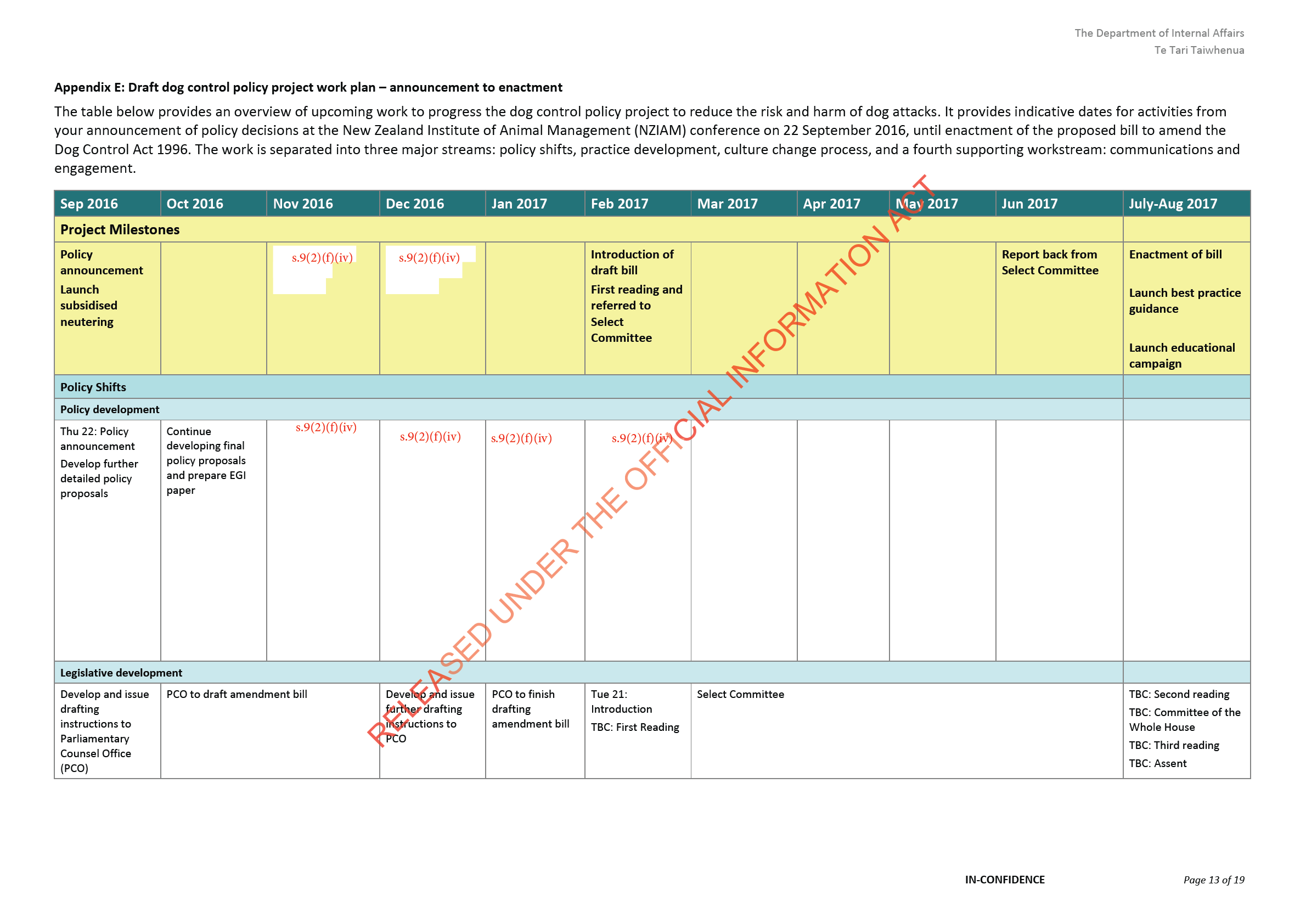

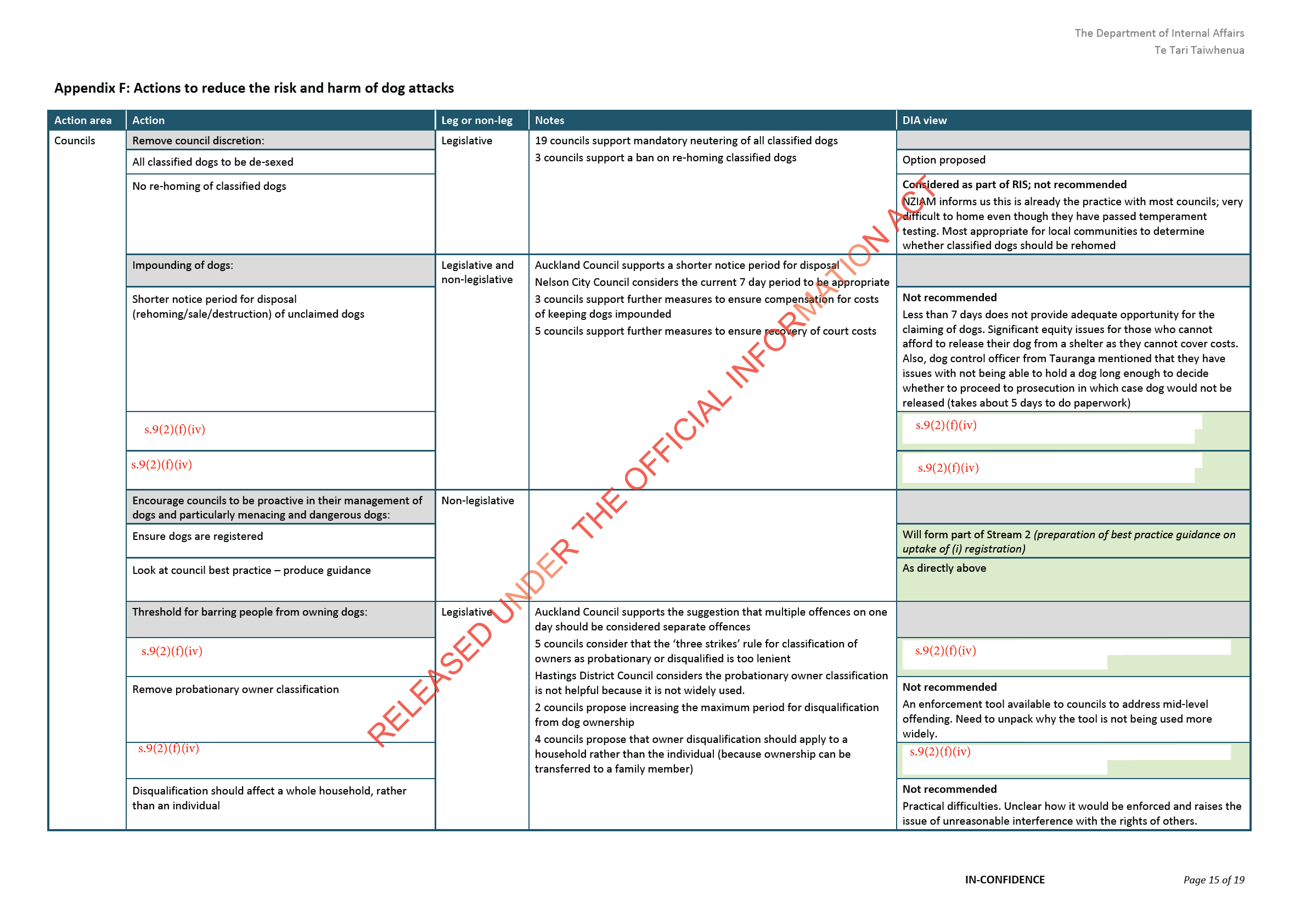

ACT
s.9(2)(f)(iv)
INFORMATION
OFFICIAL
RELEASED UNDER THE

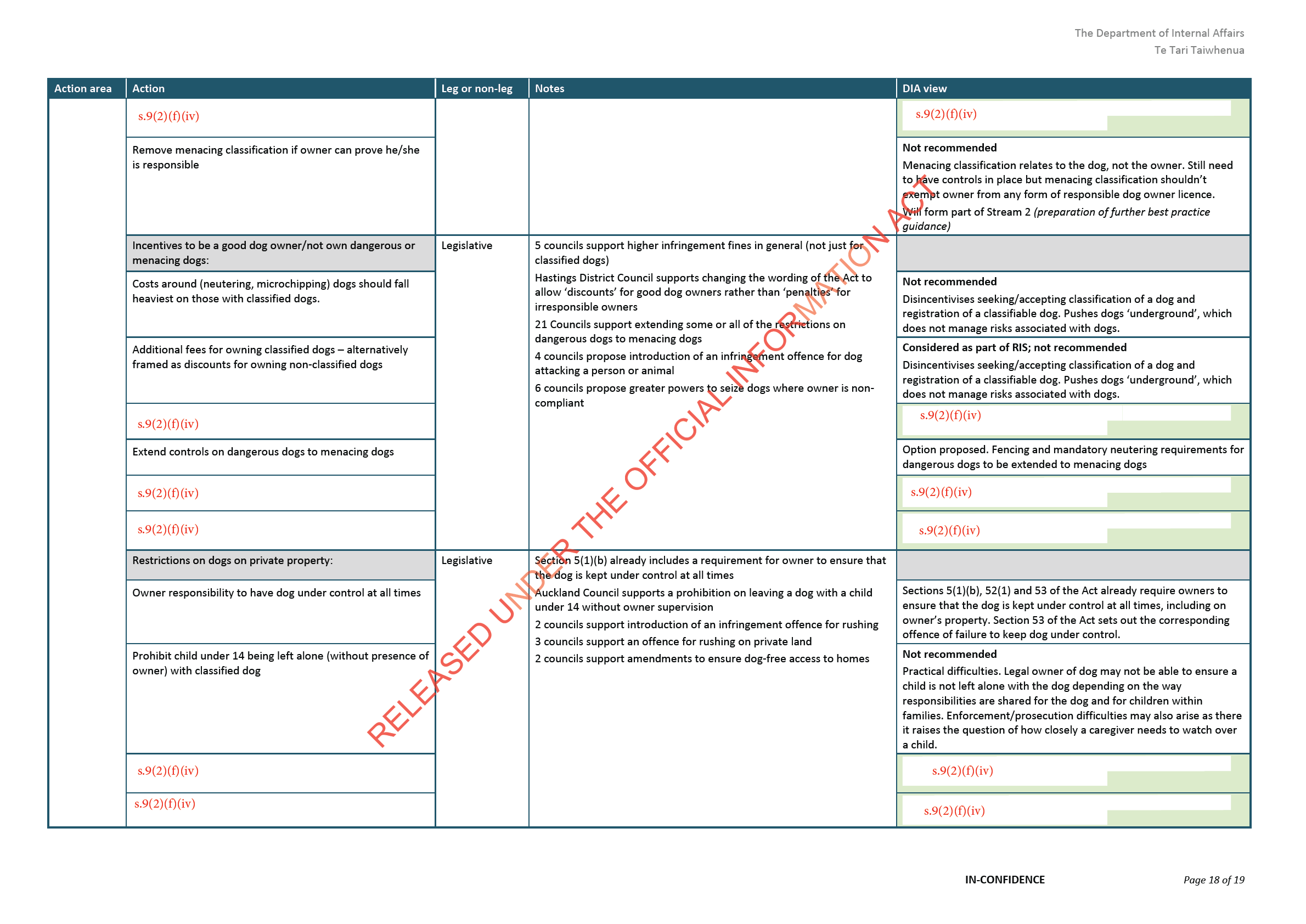
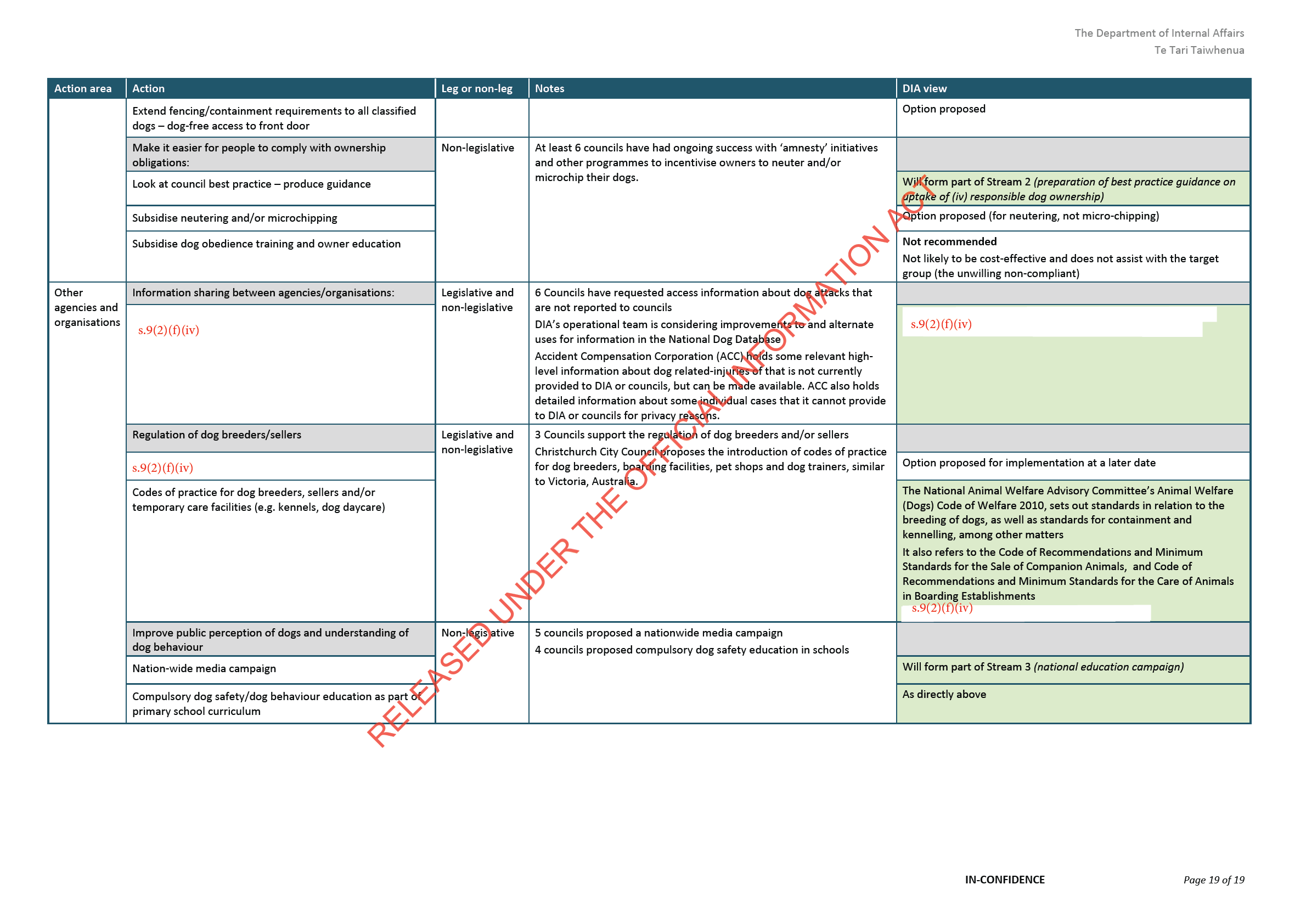

ACT
N
NFOR
INFORMATION
FI
OFFICIAL
R
RELEASED U
RELEASED UNDER THE
link to page 12 link to page 13 link to page 13 link to page 14 link to page 15 link to page 17 link to page 18 link to page 18 link to page 20 link to page 22 link to page 24 link to page 27 link to page 27 link to page 27 link to page 28
IN-CONFIDENCE
Contents
Agency disclosure statement .............................................................................................1
Contents ............................................................................................................................2
Executive summary .......................................................................................................... .3
ACT
Status quo and problem definition ............................................................................
.....3
The underlying causes of dog attacks .................................................................... .... ....... 4
Problems to be solved ........................................................................................ ................ 5
Objectives and Criteria ................................................................................... ...................7
Options and impact analysis ..............................................................................................8
Problem Area 1: Involvement of unregistered dogs in a large proportion of attacks ........ 8
Problem Area 2: Lack of socially-responsible behaviour by dog owners ......................... 10
Problem Area 3: Lack of reporting of dog bite incidents to territorial authorities .......... 12
INFORMATION
Summary of analysis of options for reducing harm and risk of dog attacks ........................ 14
Consultation ................................................... .... ........................................................... 17
Conclusions and recommendations ........... ... .................................................................. 17
OFFICIAL
Implementation plan ....................................................................................................... 17
E OFFICIAL
Monitoring, evaluation, and review ................................................................................. 18
D UND
RELEA
RELEASED UNDER THE
Page 2 of 19
IN-CONFIDENCE
Executive summary
1.
The Government is reviewing the policy settings around dog control to determine if central
and local government can do more to improve public safety around dogs. This is to address
concerns that serious dog attacks continue to happen, with long lasting impacts for victims
and families.1
2.
The Department has evaluated the status quo and a number of options being considered
by the Government to reduce the risk and harm of dog attacks. The options fall into three
broad categories: Measures to deal with the high number of unregistered dogs involved inACT
the dog attacks, measures to increase socially-responsible behaviour among dog owners,
N
and measures to address the current lack of reporting of dog bite incidents to territorial
authorities.
Status quo and problem definition
3.
Any interaction between dogs and humans involves some risk. The central objective of
dog control policy is to strike an appropriate balance between the advantages to
individuals and communities of dog ownership and the protection of individuals and
NFOR
INFORMATION
communities from dog attacks. In New Zealand, dog control is regulated by the Dog
Control Act 1996 (the Act), which is implemented by territorial authorities. The Act
provides for the management of increased levels of risk associated with dogs and dog
owners by means of classification. Classification of dogs (as menacing or dangerous) and of
owners (as probationary or disqualified) allows for appropriate controls to be put in place
FI
for the protection of the community.
4.
A territorial authority:
OFFICIAL
4.1
Must classify a dog as dangerous where an owner is convicted of an offence under
57A of the Act, or where, on the basis of sworn evidence, the council believes a dog
is a threat to public safety or where the owner records in writing that it is a threat
to public safety; R
4.2
Must classify a dog as menacing if there are reasonable grounds to believe it
belongs wholly or predominantly to one or more of the breeds or types of dog that
it is illegal to import into New Zealand (under Schedule 4 of the Act). There are four
listed
breeds (Dogo Argentino, Brazilian Fila, Japanese Tosa, Perro de Presa Canario)
and one
type (American Pit Bull Terrier); and
4 3
May classify a dog as menacing if it believes the dog poses a threat to public safety
because of its behaviour.
5.
Dogs classified as dangerous
must be kept in a fenced part of the owner's property,
must
be muzzled, on a leash in public and neutered. Dogs classified as menacing
must be
muzzled in public, and councils
may require them to be neutered. Approximately two-
thirds of councils
RELEASED U have adopted mandatory
RELEASED UNDER THE neutering. Where such a policy is adopted, a
non-compliant owner can be fined (upon conviction) and the territorial authority can seize
the dog and retain it until the owner is willing to comply, or dispose of the dog.
1 Serious dog attacks can be defined as an interaction with a dog which results in serious injury (i.e. requiring
emergency/hospital treatment) or death or which has the potential for such.
Page 3 of 19
IN-CONFIDENCE
6.
Most councils have a policy of ‘no rehoming’ of classified dogs, meaning these dogs are
destroyed.
7.
Since 2013, the number of dogs classified as menacing has steadily increased by six
percent. The number of dogs classified as dangerous has increased by two percent over
the same period, although the rate of annual change is more variable. The percentage of
menacing and dangerous dogs in the total population of registered dogs has remained at
1.6 percent for the last four years.
8.
Dog owners have a number of obligations under the Act. These include registering their
dog with the local council before it is three months old or when the owner receives the
ACT
dog, and micro-chipping their dog when it is registered for the first time (except for farm
N
dogs), or if it has been classified as dangerous or menacing. Dog owners must also make
sure the dog does not startle or injure any person or any other animal and is kept under
control at all times; and care for their dog (providing adequate food, water and shelter and
exercise).
9.
Dog owners must take all reasonable steps to ensure that the dog does not:
cause any nuisance to any other person, for example by constant barking, howling or
roaming
injure, endanger or cause distress to any stock, poultry domestic animal or protected
NFOR
INFORMATION
wildlife
damage or endanger any property belonging to another person.
10.
The penalty for owning a dog involved in an attack causing serious injury is up to three
years’ imprisonment and/or a fine of up to $20,000. The penalty for not registering a dog
FI
is $300 as it the penalty for not micro-chipping a dog if required to do so.
11.
There were 415,144 owners of registered dogs in New Zealand in 2016. This number has
OFFICIAL
increased by 7 percent since 2013. Currently dog owners do not require a license.
12.
Evidence from councils and animal management officers is that irresponsible dog
ownership is largely attributable to (i) a lack of owner education about dog behaviour and
how to be responsible (ii) socio-economic factors resulting in an inability to meet extra
R
costs associated with responsible ownership, and (iii) unwilling non-compliant attitudes
among members of society. Anecdotal evidence is that animal welfare issues are also
extensive across New Zealand.
The underlying causes of dog attacks
13.
The causes of dog attacks are known to be multifactorial. Literature identifies five key
interacting factors as determinants of the tendency of a dog to bite, namely:
heredity (genes, breed2),
early experience,
socialisation and training,
RELEASED U
RELEASED UNDER THE
health (physical and psychological), and
victim behaviour.
2 Pit bull type dogs have been bred to eliminate submission inhibition. As such, even if an individual pit bull
type dog does not have aggressive tendencies it has a latent potential for significant harm should an incident
arise where the dog becomes stressed/agitated.
Page 4 of 19
link to page 29
IN-CONFIDENCE
14.
Reducing the risk and harm of attacks warrants actions to address all five key factors. In
terms of other relevant factors, international research findings are that:
Male dogs are more likely to bite than females
Dogs not neutered are more likely to bite than those that are neutered
Chained dogs are more likely to bite than unchained dogs
Dogs with “dominance aggression” are more likely to be 18-24 months old
Dogs bred at home are less likely to bite than dogs from breeders and pet shops
Dogs are more likely to bite the older they are when they are obtained
ACT
Biting dogs are more likely to live in areas of lower median income
Dogs are more dangerous when acting as a pack
15.
International experience has shown that breed-specific approaches has not been
successful in reducing dog attacks, and the trend observed is a move away from this
approach. Reasons why it is not successful include:
Breed alone is not an effective indicator or predictor of aggression in dogs and
focussing on particular breeds fuels the misperception that other dogs won’t bite.
It is not possible to precisely determine the breed of the types of dogs targeted by
breed-specific legislation by visual identification or by DNA analysis.
INFORMATION
INFORMATION
Breed-specific legislation ignores the human element whereby dog owners who desire
this kind of dog will simply substitute another breed of dog of similar size, strength and
perception of aggressive tendencies.
CIAL
Problems to be solved
OFFICIAL
16.
The number of registered dogs in New Zealand has been increasing slightly over the past
decade.3 There were an estimated 492,741 registered dogs in 2007, and in 2016 there are
an estimated 533,216 registered dogs
(Figure 1). Over the last few years the number of
registered dogs per capita has remained stable, at about 12 dogs per 100 people.
17.
Ministry of Health data shows that the number of hospitalisations for dog bites4 has
increased by 53 percent from 457 in 2005 to 724 in 2015 (Figure 2). The rate of
hospitalisations by population is also increasing, with a rate of 15.8 hospitalisations per
100,000 people in 2015. The annual rate of change is variable with discharges in the last
three years showing little change.
18.
Otago University’s Injury Prevention Unit’s (IPU) data shows that the number of
hospitalisations for dog bites
5 increased by 72 percent from 276 in 2000 to 474 in 2014
(Figure 2).6 Both the IPU and MoH data show a significant increase in discharges in 2011,
and a slowing/reduction in the rate of growth of hospitalisations over the last few years.
3
RELEA
RELEASED UNDER THE
The National Dog Database provides information on the number of registered dogs by councils. However,
prior to 2013 not all councils supplied data for every year. In addition, the number of registered dogs does not
reflect the total dog population in New Zealand.
4 MoH analysis is for publicly funded hospital discharges with the cause code 'W54: Contact with dog', using
ICD10 classification.
5 IPU analysis is for publicly funded hospital discharges with the cause code 'W54: Contact with dog', using
ICD10 classification.
6 IPU analysis also originates from data collected and supplied by MoH. But as well as being subject to other
selection criteria, IPU data excludes day patients. Hence, the much lower numbers than for MoH data
presented here.
Page 5 of 19
IN-CONFIDENCE
19.
ACC data on dog-related injury claims shows a 25 percent increase in the number of active
claims from 10,196 in 2006 to 12,695 in 2015 (Figure 3).7 The total pay-out for dog-related
injuries from 2006 to 2015 was $34.860 million. In 2015, the average cost per claim was
$407, and while there has been more annual variation in the average cost per claim than
for the number of active claims, the cost of the average claim still increased by 72 percent
from 2006 to 2015.
20.
Both ACC claim and hospitalisation data show that most dog-related injuries and incidents
occur in the home, followed by those that occur on the street (Figure 4). This finding is
supported by findings overseas.8
ACT
21.
According to the IPU data, just under 30 percent of the patients discharged were underN
the age of 10. In contrast the ACC claims data shows the peak rate of claims is for clients in
the 50-54 age range (Figure 5). This suggests that while more people may claim for ACC
injuries requiring treatment at older ages, the impact of dog-related injuries appears to be
greater on younger people.
22.
There are three main problem areas that have been identified with respect to dog control.
These are discussed below. In the absence of government intervention, the number and
severity of dog attacks may continue. Although it is noted that data there has been a
levelling-off in hospitalisations in the last few years.
NFOR
INFORMATION
Problem Area 1: There are potentially a large number of unregistered dogs in
New Zealand; unregistered dogs are over-represented in dog attacks
23.
Risk associated with dogs a greatly increased by not having appropriate controls on them.
Applying the appropriate controls requires dogs to be ‘in the system’ rather than
FI
‘underground’.9 Dog registration is considered to be the cornerstone of effective dog
control because it links dog control services to dog owners, allows for the appropriate
OFFICIAL
placement of controls on individual dogs, and provides a source of revenue for dog control
activities.
24.
The recent Auckland Council amnesty which resulted in over 1500 unregistered dogs being
brought forward for registration indicates that the current dog registration system is not
R
effectively enforced There are 100,000 registered dogs in Auckland and Auckland Council
estimates that there are approximately 100,000 unregistered dogs. There are indications
there is a similar problem of under-registration across the country, although evidence is
limited.
25.
Evidence from councils and the New Institute of Animal Management is that dogs
classified as being of “pit bull-type”10 are over-represented in attacks. In the Auckland
area, for the 2015/16 year, 38 percent of the prosecutions taken were against actions of
pit bull types and crosses. Rotorua and Gisborne District Councils have also submitted that
pit bull types are over-represented in attacks. Enforcement practice largely relies on
removal of the dog but achieving an overall reduction in the number of these dogs is
challenging due to their high availability.
RELEASED U
RELEASED UNDER THE
7 It should be noted that the ACC claims data is for dog related injuries and includes more than just ‘attacks’ or
‘bites’.
8 Australian Veterinary Association
“Dangerous dogs – a sensible solution: Policy and model legislative
framework” (August 2012).
9 It is for this reason that any sort of ban on ownership of dog types or breeds is not considered a feasible
option and therefore is not assessed alongside other options in this analysis.
10 It is important to note that councils rely on a visual classification, which as discussed earlier, is not
considered to be an effective method of identifying the breeds of a mixed-breed dog.
Page 6 of 19
link to page 17
IN-CONFIDENCE
Problem Area 2: There is a lack of socially-responsible behaviour among dog
owners
26.
Owners are crucial determinants of the risk associated with the dog and are key in
managing that risk once it has been identified (i.e. when dog has been classified as
menacing or dangerous). As such, ingraining responsible attitudes to dog ownership is an
important area of action. Evidence from councils is that in general dog owners are not
well-equipped to take on the responsibilities of dog ownership (the ‘unable,
noncompliant’) and/or willing to do so (the ‘unwilling, non-compliant’). Councils and other
stakeholders consider measures are needed to encourage responsible dog ownership and ACT
discourage negligent and reckless behaviour. Part of socially- responsible ownership isN
mitigating risk to others, including by communicating high risk to members of the public so
that they may modify their ‘risky’ behaviour.
Problem Area 3: Territorial authorities are not receiving accurate information
about dog bite incidents in their area
27.
Councils can only investigate attacks they are made aware of, generally by the victim or
someone else involved in the incident. There are no mandatory requirements on health
professionals or agencies (such as the Accident Compensation Corporation) to notify
NFOR
INFORMATION
councils of an incident they become aware of. Councils have noted that without accurate
information about the presence and behaviour of dogs in their district, it is not possible for
councils to effectively address high-risk dogs or owners.
FI
Objectives and Criteria
OFFICIAL
28.
The objectives of this review are to further refine regulatory settings to:
28.1 Improve community and individual safety from the threat and harm of dog attacks;
28.2 Support the welfare of animals and the valuable role dogs play in our society and
individual well-being; and
R
28.3 Increase effectiveness the dog control regime.
29.
Options were assessed using the following criteria:
Effective: the option achieves the desired outcomes and addresses the problems
identified;
Efficient: the requirements minimise compliance costs and are no more than
necessary to achieve the outcomes sought;
Equitable: the requirements are fair and are consistently applied;
Clear and transparent: people understand what is required of them and the basis of
decisions; and
RELEASED U
RELEASED UNDER THE
Cost-effective: the option is a cost-effective expenditure of public funds.
30.
The single criterion of ‘effectiveness’ provides the assessment of how well each option
meets the three objectives outlined in paragraph
28.
Page 7 of 19
IN-CONFIDENCE
Options and impact analysis
31.
Within each of the problem areas identified, options with regulatory impacts are discussed
below. It should be noted that those options being considered are part of a wider package
that includes (i) a national public education campaign to increase awareness of dog
behaviour and safety and socially responsible dog ownership, (ii) best practice guidance
for territorial authorities to better approach enforcement challenges in a nationally
consistent way, and (iii) a potential nation-wide subsidised neutering campaign for
classified dogs.
ACT
N
Problem Area 1: Involvement of unregistered dogs in a large
proportion of attacks
Measures to increase registration uptake
NFOR
INFORMATION
s.9(2)(f)(iv)
FI
OFFICIAL
R
RELEASED U
RELEASED UNDER THE
Page 8 of 19
IN-CONFIDENCE
Option 2 Regulation of sale of dogs
38.
This option would also place obligations on a seller to ensure registration has been carried
out prior to sale. As a large number of litters are unplanned and unwanted, owners may
not be aware of obligations. Currently a large number of ‘sales’ are informal. Therefore,
such a rule may be hard to enforce and potentially force sales further ‘underground’. Also,
there is a risk that such a policy could result in ‘backyard’ euthanising of unwanted litters.
39.
This option would increase costs of enforcement at point of sale and would diminish and
undermine owner-responsibility for unregistered dogs once a ‘sale’ has been completed
As such, it is not likely to be cost-effective in the current environment where there are a ACT
large number of dogs not neutered and consequently a large number of informal sales.
This option is
not recommended.
Measures to reduce the availability of dogs considered to be pit bull type
Option 3 Mandatory neutering of all dogs classified as menacing (remove territorial
authority discretion)
40.
For dogs classified menacing
by breed, the import of such dogs is already banned. So there
is a clear rationale to require mandatory neutering. In fact, variation is this respect
INFORMATION
INFORMATION
undermines the current regime intent of restricting Schedule 4 breeds and types to restrict
these breeds in New Zealand. For dogs classified menacing
by deed, neutering is
understood to have behavioural advantages.
CIAL
41.
As such, there is no need for council variation on this matter and national consistency is
desirable. Mandatory neutering would reduce the risk that the dog will commit a serious
attack; it will also drive consistent practice across the country, and reduce costs for
territorial authorities (by streamlining and simplifying the process). Neutering also
OFFICIAL
supports animal welfare considerations as lowered aggression results in reduced risk of
the dog attacking and having to be euthanised.
42.
Overall mandatory neutering would enhance the effectiveness of the dog control regime,
but there is a risk that some owners that wish to breed dogs that are classifiable menacing
or dangerous will try to evade collection of accurate breed information via the registration
system. It may also increase costs for councils if owners become less likely to seek or
accept classification of dogs where it is appropriate.
43.
This option increases equity between owners of menacing dogs as they are not subjected
to regional variation and there is 'one rule for all'. However, dogs that are classifiable
menacing by breed tend to be owned by those in lower socio-economic groups. As such, in
practice it may impose more costs on those who can less afford it.
44
This option is
recommended as it meets objectives better than the status quo and is cost-
effective overall.
Option 4 Ban on re-homing of dogs classified as menacing or dangerous
RELEA
RELEASED UNDER THE
45.
Currently, many councils have a policy of no re-homing of dogs classified menacing or
dangerous from their council shelters. This option would make that rule consistent across
all councils and welfare agencies. This option is supported by stakeholders such as the
New Zealand Institute of Animal Management.
Page 9 of 19
IN-CONFIDENCE
46.
This option would seek to lower the population of dogs with potential for high harm (for
dogs menacing by breed) and high-risk (for dogs classified by deed). But the extent to
which this option would be particularly effective depends on whether dogs, once classified
and rehomed, are over-represented in dog attacks. There is no data on this. It does not
support animal welfare considerations, particularly where a dog maybe well-adjusted and
non-aggressive, but classified by breed due to its potential for significant harm should
there be an attack. Such a ban may disincentivise owners to seek or accept classification of
dogs where it is appropriate. People may also be less likely to surrender dogs to the
council if there was such a ban. It is also important to note the current lack of clarity and
consensus around how to identify dogs as ‘pit bull type’, and concerns about the accuracy ACT
of visual classification. The option would reduce shelter costs and would therefore save
N
costs for councils however.
47.
This option is
not recommended due to the current challenges with visual classification
and because local communities currently have the flexibility to implement no re-homing
policies if they wish to do so.
Problem Area 2: Lack of socially-responsible behaviour by dog
owners
NFOR
INFORMATION
s.9(2)(f)(iv)
FI
OFFICIAL
R
RELEASED U
RELEASED UNDER THE
Page 10 of 19
IN-CONFIDENCE
s.9(2)(f)(iv)
ACT
Option 6 Extend fencing/containment requirements to all menacing dogs
56.
This option would extend current containment requirements on owners of dogs classified
as
dangerous to also apply to owners of dogs classified as
menacing. Dogs classified as
menacing would have to be confined to the land in a manner that they could not freely
leave and kept in a securely fenced portion of the owner’s property that it is not necessary
to enter to obtain access to at least one door of the dwelling It would significantly reduce
the risk of people inadvertently encountering high-risk dogs on private property, dogs
INFORMATION
INFORMATION
roaming/running off the property when provoked, and becoming agitated due to chaining.
It would support the effectiveness of the dog control regime as currently a large part of
dog control work is a result of dogs not being contained on their property.
57.
A fencing requirement increases the cost of ownership of a menacing dog. It would
disadvantage some owners, such as those who do not own their own house and those on
low incomes, who are more likely to own dogs that are likely to be classified as menacing
OFFICIAL
by breed. However, this option is likely to be cost-effective for councils, as homes and
streets are the most common places for dog attacks to occur. This option is
recommended.
THE OFFICIAL
Option 7 Mandatory special collars to identify classified dogs
58.
This option would require owners to ensure dogs classified as menacing or dangerous are
wearing identifiable, specially designated collars for each classification. The collar would
be supplied by council at a cost to the dog owner.
59.
The option seeks to enable the public and visitors to private property housing a classified
dog to be well informed of risk, and those on the street when a dog may have escaped the
property without the owner’s knowledge (and so is not wearing a muzzle). As evidence
suggests most incidents occur within the home or on the street, a visual collar would be a
well-targeted measure. However in the public sphere, in many cases if an owner does not
wish to use in a muzzle, they are unlikely to leave such a collar on because to do so is more
likely to attract an infringement for failure to muzzle under section 33EC of the Act.
Therefore, such a requirement is likely to only be complied with by already responsible
RELEASED UNDER
RELEASED UNDER THE
owners who would already be using a muzzle when in public. As such, this option may be
considered to be more than the minimum necessary in terms of communicating risk to the
public.
Page 11 of 19
IN-CONFIDENCE
60.
The requirement to wear a signifying collar could also result in stigma that results in less
socialisation for the dog, but it is unclear to what extent this may occur. The potential for
such stigma will also vary from community to community. As with other measures that
increase controls and costs of ownership, there is a risk of further disincentivising dog
registration.
61.
It is unclear whether the costs to individuals of this option would outweigh its
effectiveness in terms of reducing risk and harm of attacks and further investigation is
warranted on how well this measure has worked overseas. As such it is
not recommended
at this stage.
ACT
Option 8 Mandatory display of signs on properties housing dogs classified as menacing
N
or dangerous
62.
This option would require owners to ensure a property housing a dog classified as
menacing or dangerous has a specially designated sign displayed on the property. Signs
would be supplied by councils and so would be standardised.
63.
The option seeks to enable the public and visitors to private property housing a classified
dog to be well informed of risk. As most attacks occur in the home, this option is
considered to be a well-targeted measure. However, the option would be more than the
NFOR
minimum necessary to achieve objectives for dangerous dogs for which section 32 (1)(a)
INFORMATION
requires that the dog be contained within a securely fenced portion of the owner’s
property that it is not necessary to enter to obtain access to at least one door of any
dwelling on the property. Furthermore, option 6 would extend this fencing requirement to
also apply to properties housing dogs classified as menacing. If that measure was to be
adopted, then this option would also be more than the minimum necessary for dogs
FI
classified as menacing, and therefore not meet the efficiency criterion. However, like
OFFICIAL
option 6, this option would be a further mitigation of the risk and harm of dog attacks.
64.
The option adds compliance cost for owners of purchasing a sign. As with other measures
that increase controls and costs of ownership, there is a risk of further disincentivising dog
registration. This option is
not recommended on the basis that option 6 is preferred.
R
Problem Area 3: Lack of reporting of dog bite incidents to territorial
authorities
Option 9 Mandatory reporting of dog bite incidents to territorial authorities
65.
A number of councils and the New Zealand Institute of Animal Management have
requested mandatory reporting of all dog bite incidents to territorial authorities. Such
reporting requirements could be applied at different levels: to GPs, hospital staff, or ACC.
Mandatory reporting would allow territorial authorities to investigate and apply
appropriate actions to educate owners on responsibilities of being a dog owner and to
place extra requirements on ownership of the dog via the classification process.
RELEASED U
RELEASED UNDER THE
66.
Current health information collected from patients for treatment purposes would not by
itself be sufficient for council enforcement purposes. Information that would be of use,
such as where a dog came from and who the owner is, is not collected. As such, councils
would have to follow up patients/claimants who may not wish to be contacted.
Page 12 of 19
IN-CONFIDENCE
67.
Sharing ACC claimants’ and/or patients’ personal information with territorial authorities
without their permission would raise privacy concerns. This is because such information is
collected for different purposes to those that territorial authorities require it for.
Therefore, appropriate legal authority to be able to share this information would be
required such as client consent obtained case by case, relying on Information Privacy
Principles exemptions11 (determined case by case), or an approved information sharing
agreement or legislative change. Requiring claimants and/or patients to provide relevant
information may have an unintended negative consequence of discouraging people from
pursuing appropriate treatment, and would go against the no-fault principle of the ACC
Scheme. Higher levels of reporting could be achieved through public education on
ACT
reporting voluntarily.
68.
This option is
not recommended.
INFORMATION
INFORMATION
IAL
OFFICIAL
RELEASED UNDER THE
RELEASED UNDER THE
11 For example, Principle 11 (e)—disclosure of personal information is necessary to avoid prejudice to
maintenance of the law or enforcement of a law; or Principle 11 (f)—disclosure is necessary to prevent or
lessen a serious threat to public health or safety.
Page 13 of 19
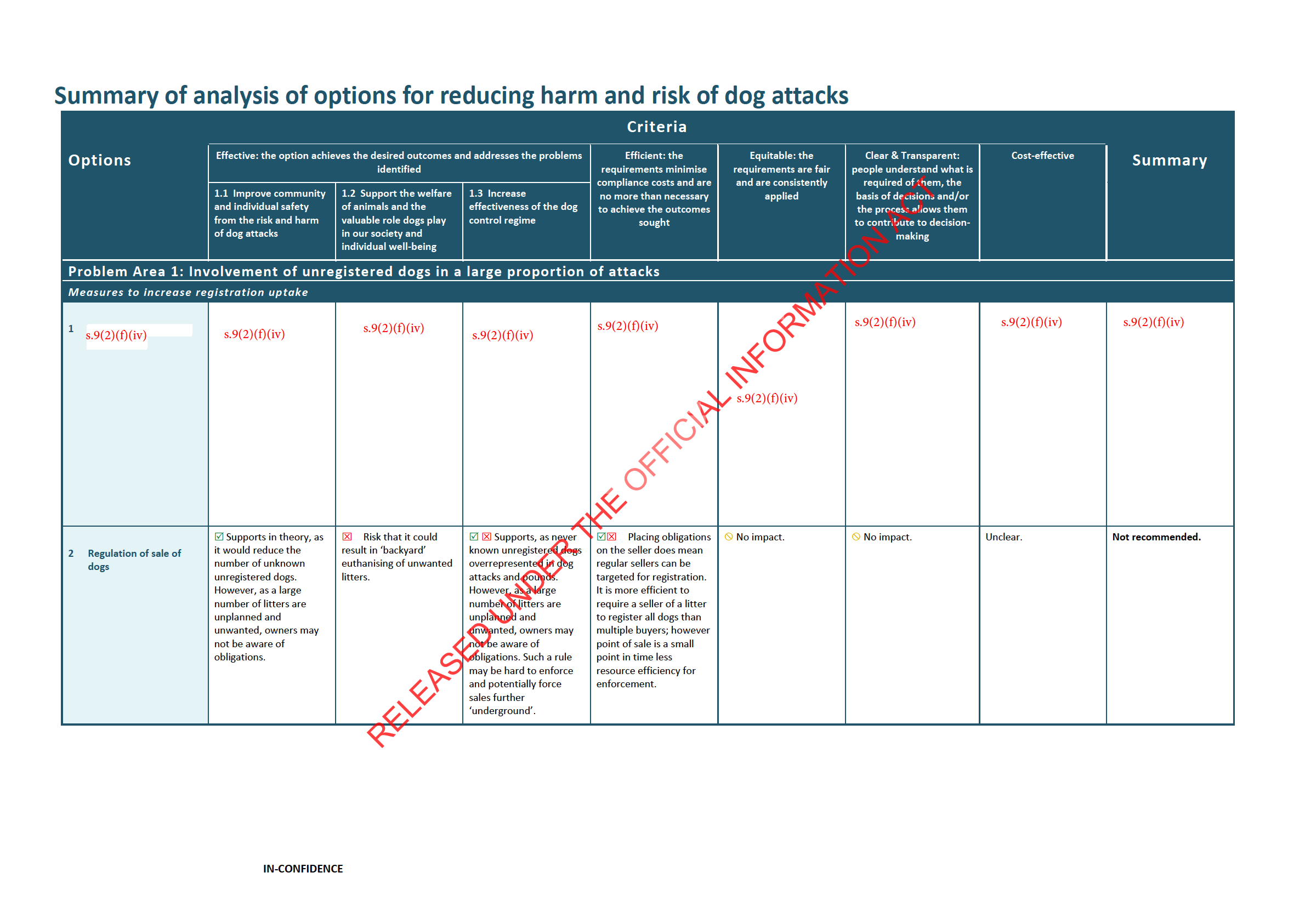
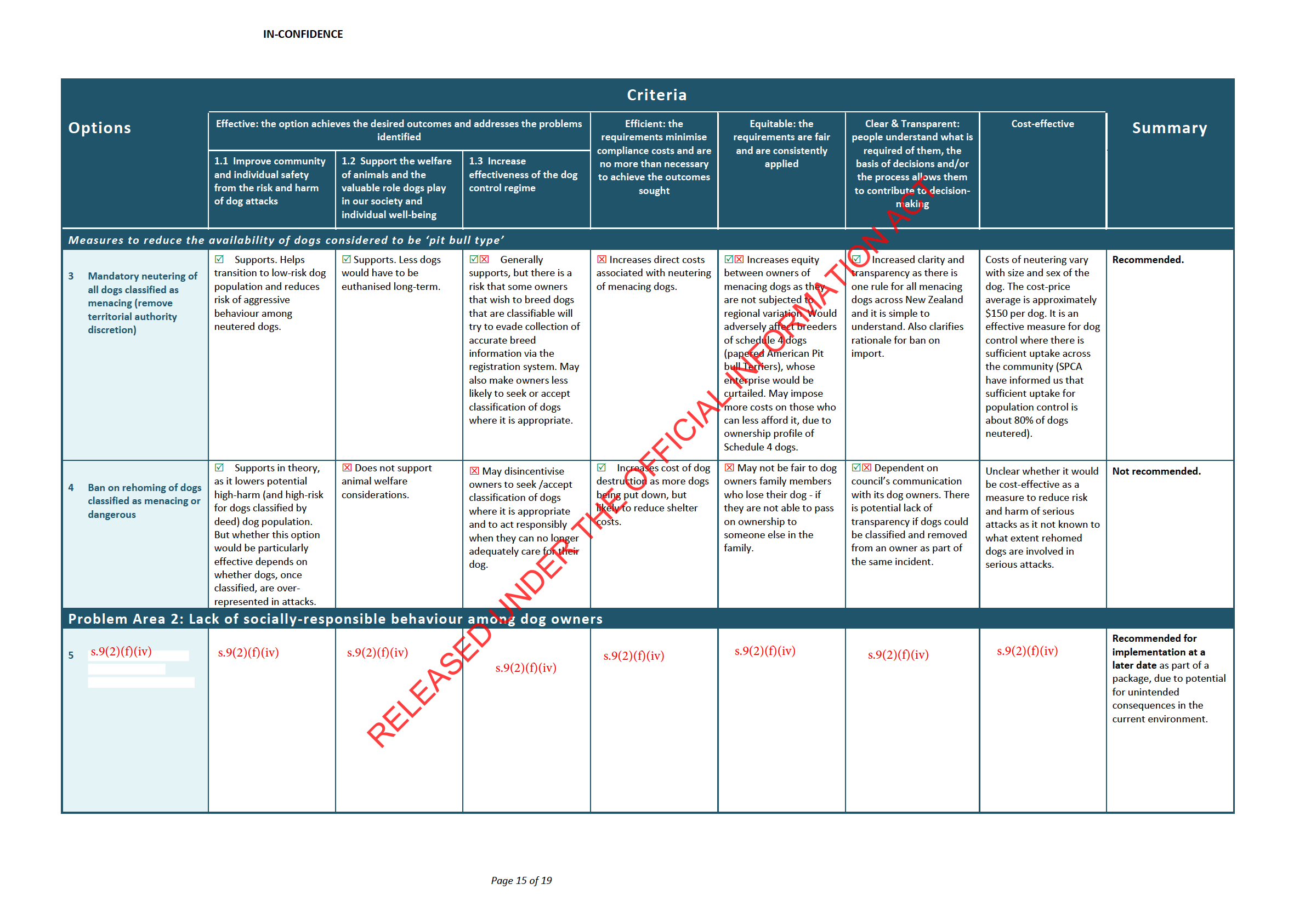

ACT
INFORMATION
OFFICIAL
RELEASED UNDER THE
Consultation
69.
In the preparation of these proposals, a range of external stakeholders were also
consulted, including Local Government New Zealand, the Society of Local Government
Managers, Auckland Council, the New Zealand Institute of Animal Management
(previously known as the New Zealand Institute of Animal Control Officers), the New
Zealand Association of Plastic Surgeons, the New Zealand Kennel Club, Federated Farmers
of New Zealand, Rural Women New Zealand, the Veterinary Council of New Zealand, Dog ACT
behaviour experts, Trade Me, and the Royal New Zealand Society for the Protection of
Animals the Pit bull Club, and the American Staffordshire Terrier Club.
70.
We also undertook targeted engagement with victims of dog bites and dog owners in
Auckland and Wellington. Officials also met with, farmers and other members of the rural
community, and animal control officers. An online engagement survey was used to
capture the sentiment of the general public about areas for improvement to the dog
control regime. The two week survey period resulted in over 3000 responses.
71.
This engagement enabled officials to gain some understanding of the nature and the size
of dog control problems and to identify potential solutions. There was broad support for
non-regulatory measures such as public and owner education, and for regulatory
INFORMATION
INFORMATION
measures such a mandatory neutering. Many also supported owner licensing. Many have
concerns about measures that increase costs and obligations for dogs classified menacing
IAL
due to being of ‘pit bull type’, as breed-specific legislation has been shown to not be
effective in other jurisdictions in reducing dog attacks.
Conclusions and recommendation
OFFICIAL
s
72.
A package of regulatory and non-regulatory interventions are required in order to achieve
the goal of reducing risk and harm of serious dog attacks. Furthermore, to be effective,
regulatory tools need to be used in a phased approach. This is because the success of more
interventionist measures (such as breeder and owner licensing regimes) depends on the
receiving environment being right. ‘Supply-side’ measures need to be adopted first to
reduce the availability of dogs that are not neutered. This combined with a societal culture
change process and more effective council action through development of best practice,
will mean the better conditions for successfully increasing controls on dogs, owners and
breeders. Potential unintended consequences of employing regulatory tools too early
include and increased number of unregistered dogs, potential for ‘backyard euthanasia’ of
dogs/unintended litters, and higher than necessary levels of euthanasia overall.
Implementation plan
RELEASED UNDER THE
RELEASED UNDER THE
73.
These proposals will be implemented as part of three phases of work.
Legislative phase: a one to two year process to amend the Act and develop regulations
as necessary (e.g. details of owner licensing scheme) to implement options preferred
by the Government;
Page 17 of 19
Best practice phase: a one to two year process (concurrent to the legislative phase),
led by the local government sector, to develop best practice guidance for the local
government sector about implementation of the Act, amendments, and associated
regulations; and
Public education phase: a longer-term process, with central and local government and
non-governmental sector working together to influence societal change in attitudes
about responsible dog ownership and safety around dogs.
74.
Work under phases 2 and 3 and the approach that will be taken has broad support across
all stakeholders.
ACT
Monitoring, evaluation, and review
75.
Monitoring will continue to occur as it does currently via the annual collation and release
of statistics relating to dog control from other agencies and the national dog database.
Annual councils dog control reports prepared under section 10A of Dog Control Act 1996
will also be reviewed to ascertain a picture of the trends. To enable this to occur, as part of
the legislative phase of this work, there are plans to review section 10A requirements, in
order to ascertain more fit for purpose information in future.
INFORMATION
INFORMATION
76.
There are no plans for a future review of proposals at this stage. There is no legislative
requirement to conduct regular reviews and such a review will likely occur as priorities
allow.
IAL
OFFICIAL
RELEASED UNDER THE
RELEASED UNDER THE
Page 18 of 19
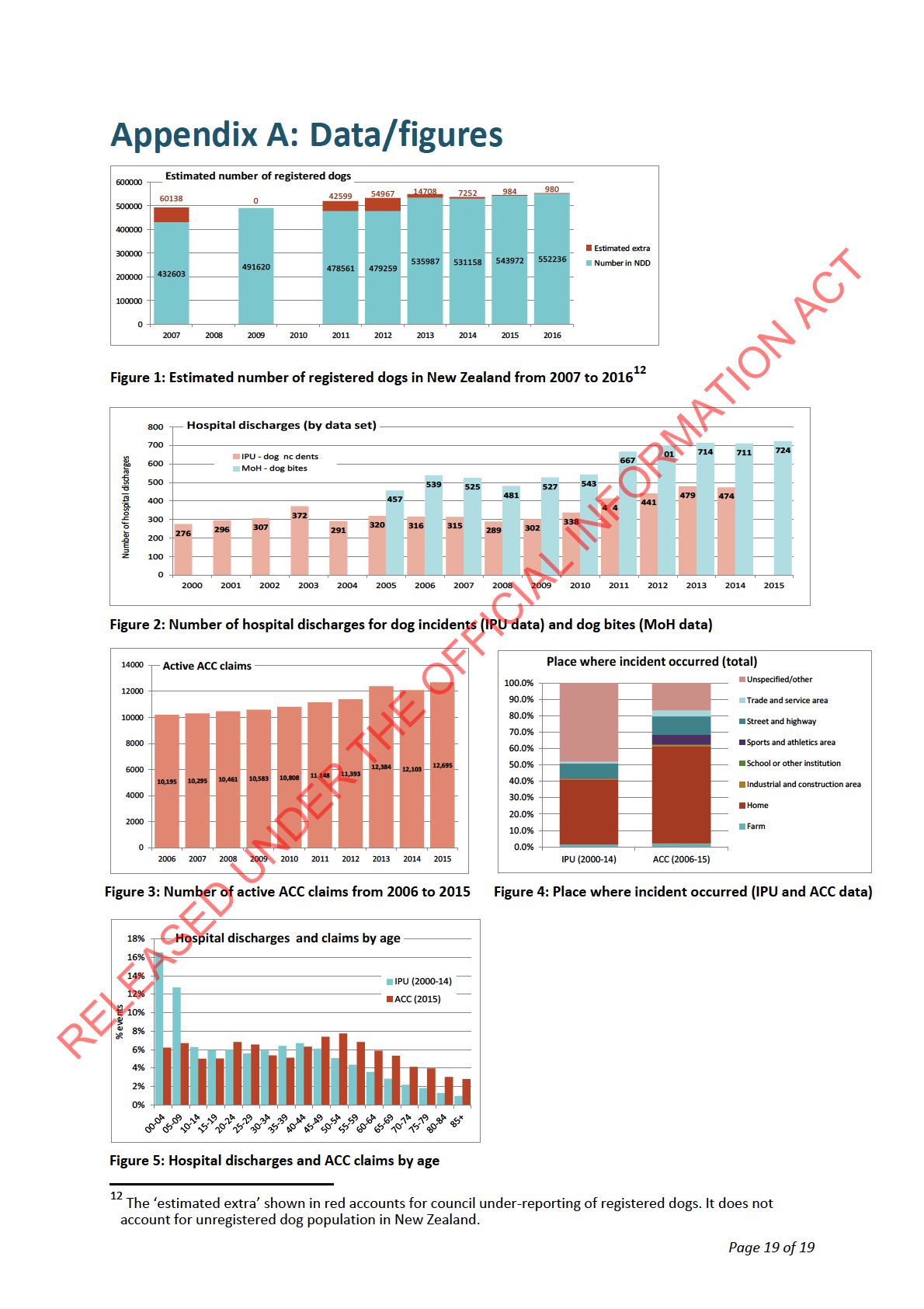
ACT
INFORMATION
RELEASED UNDER THE OFFICIAL

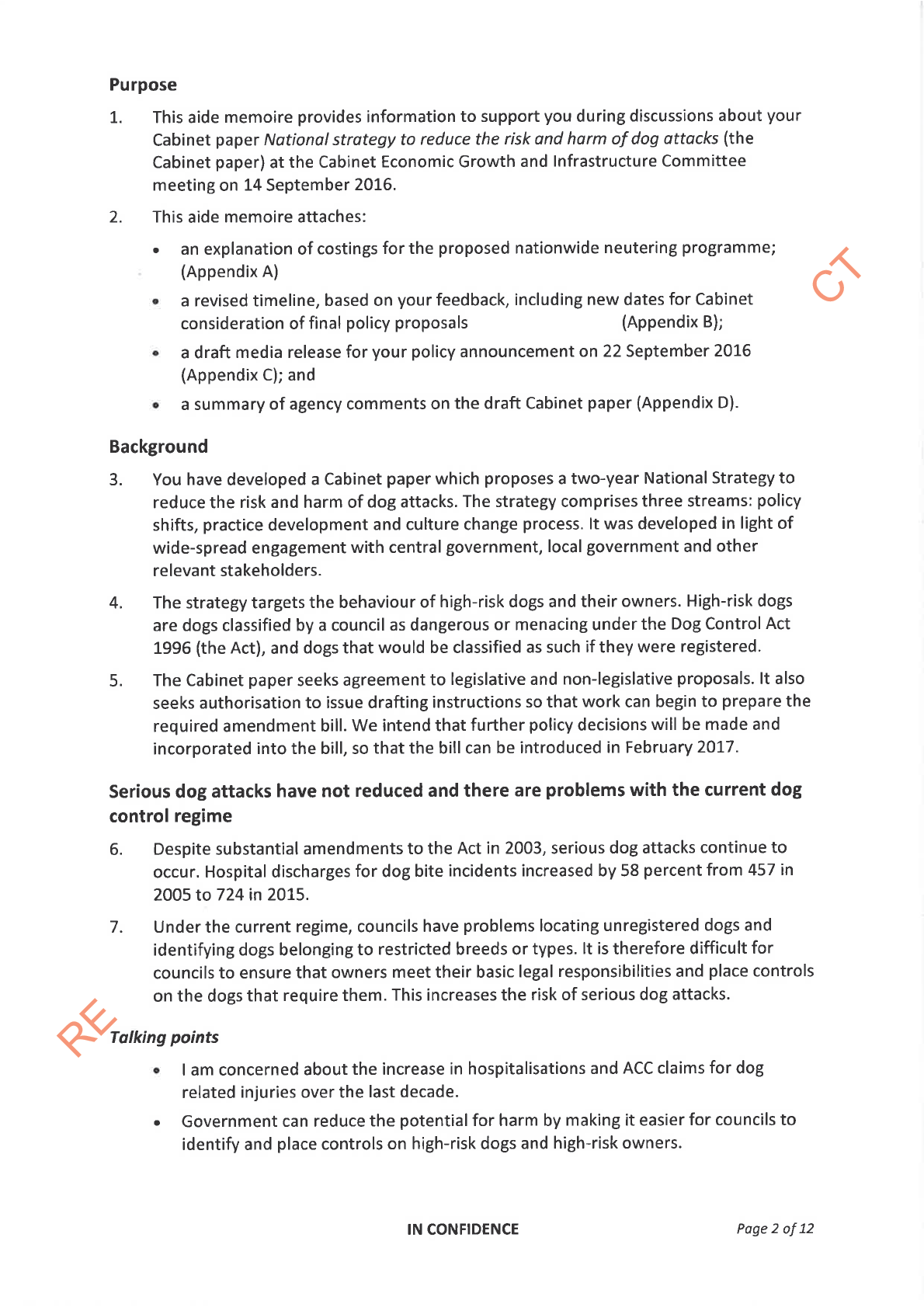
s.9(2)(f)(iv)
ACT
INFORMATION
RELEASED UNDER THE OFFICIAL
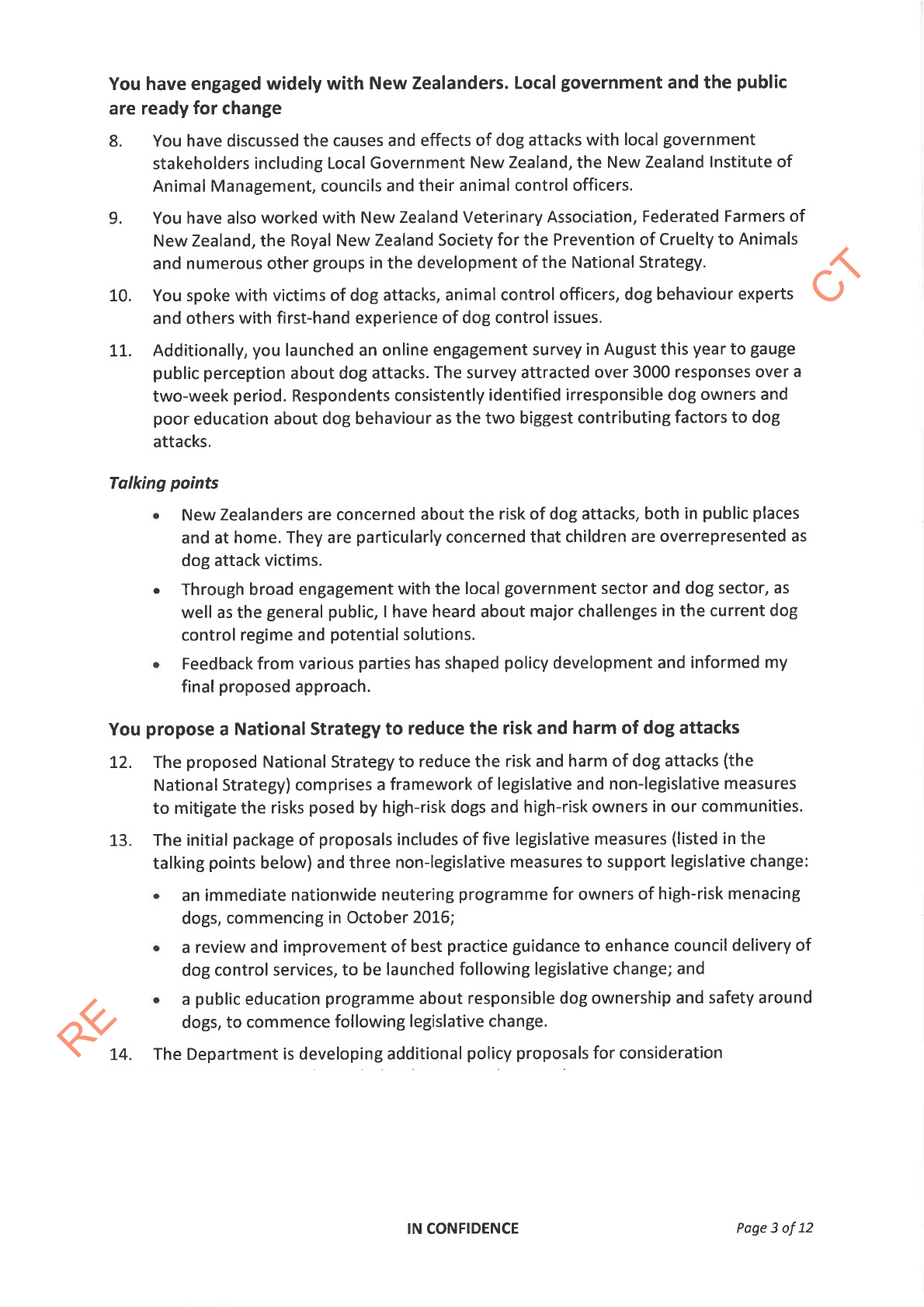
ACT
INFORMATION
RELEASED UNDER THE OFFICIAL
s.9(2)(f)(iv)

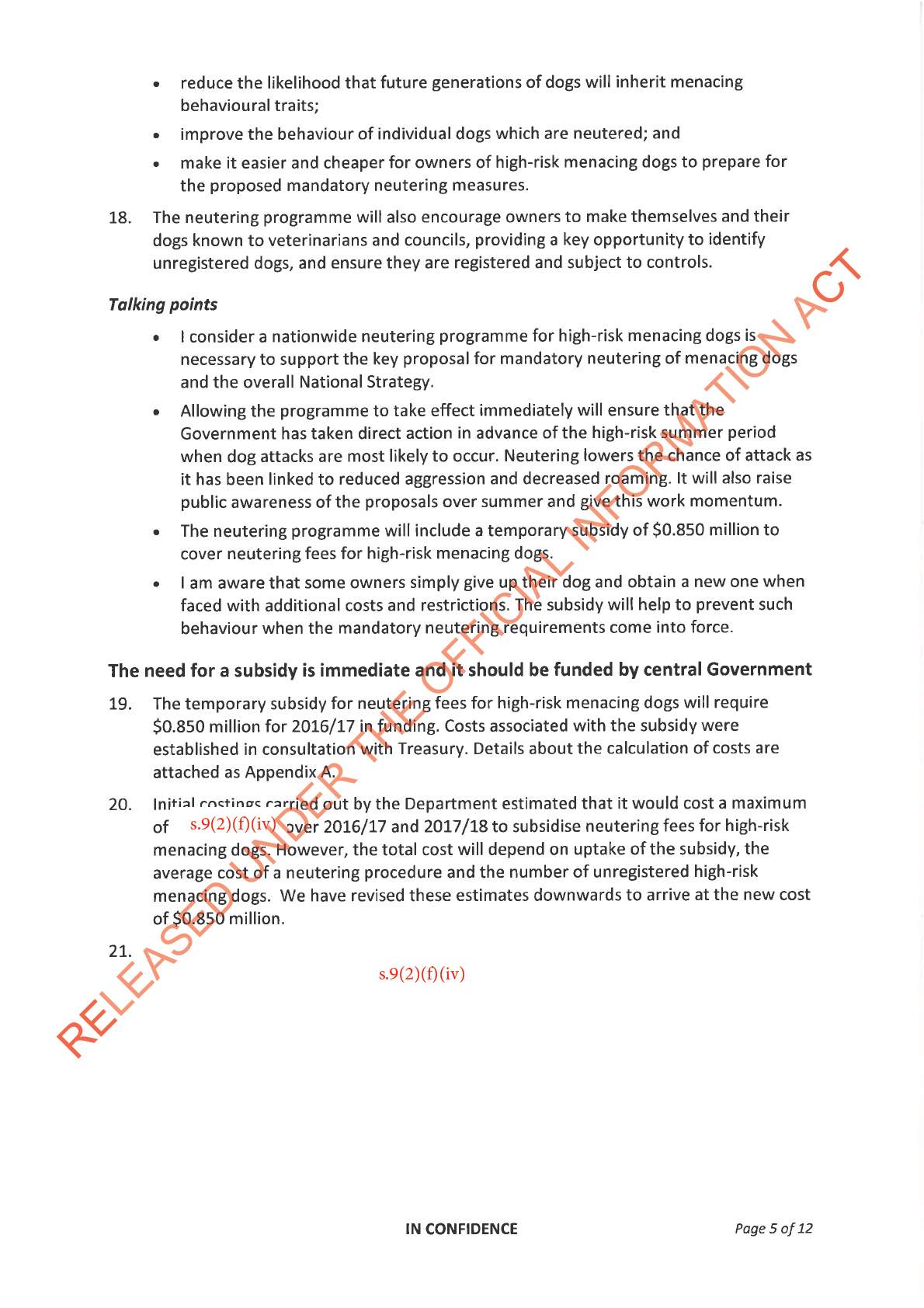
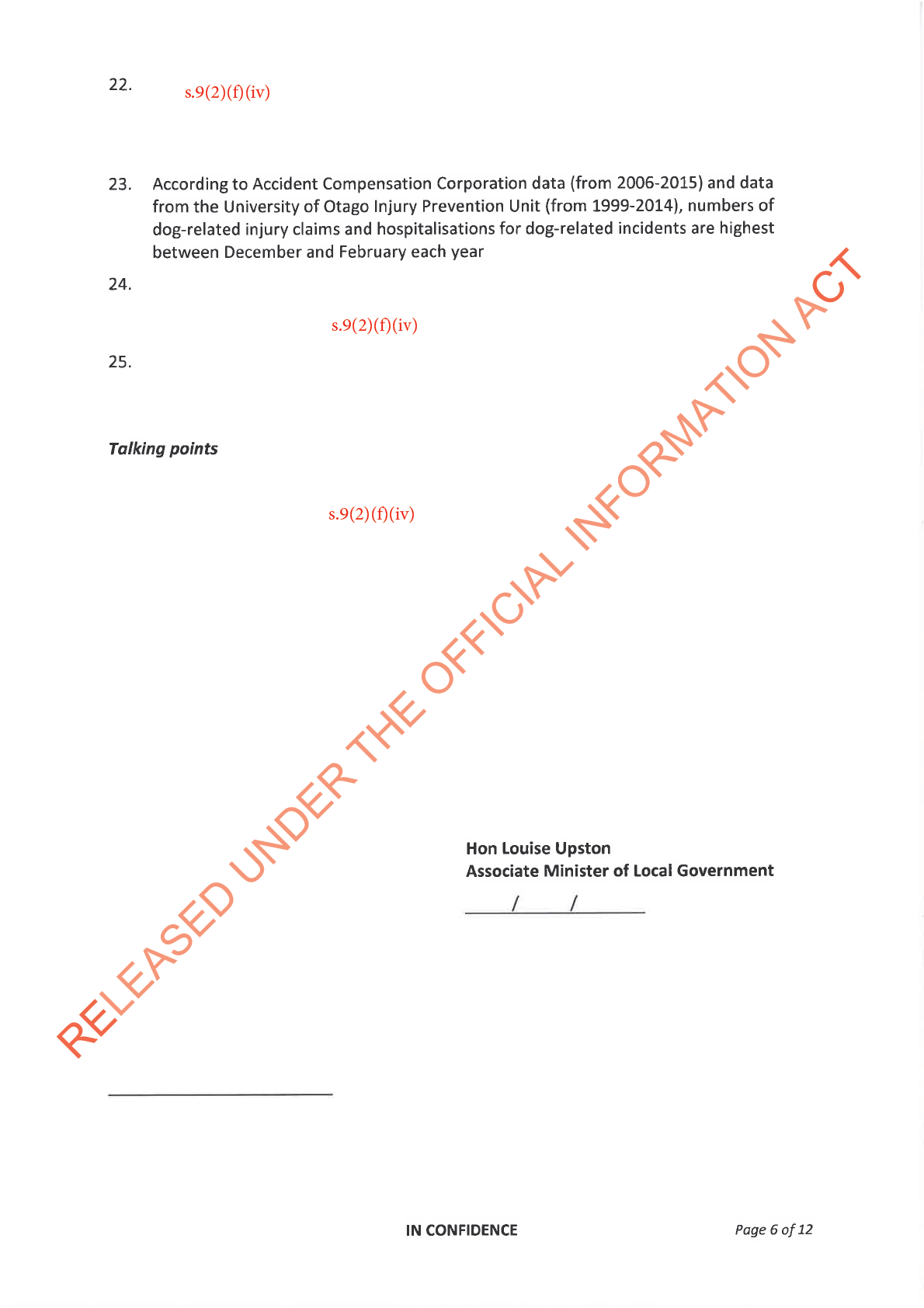
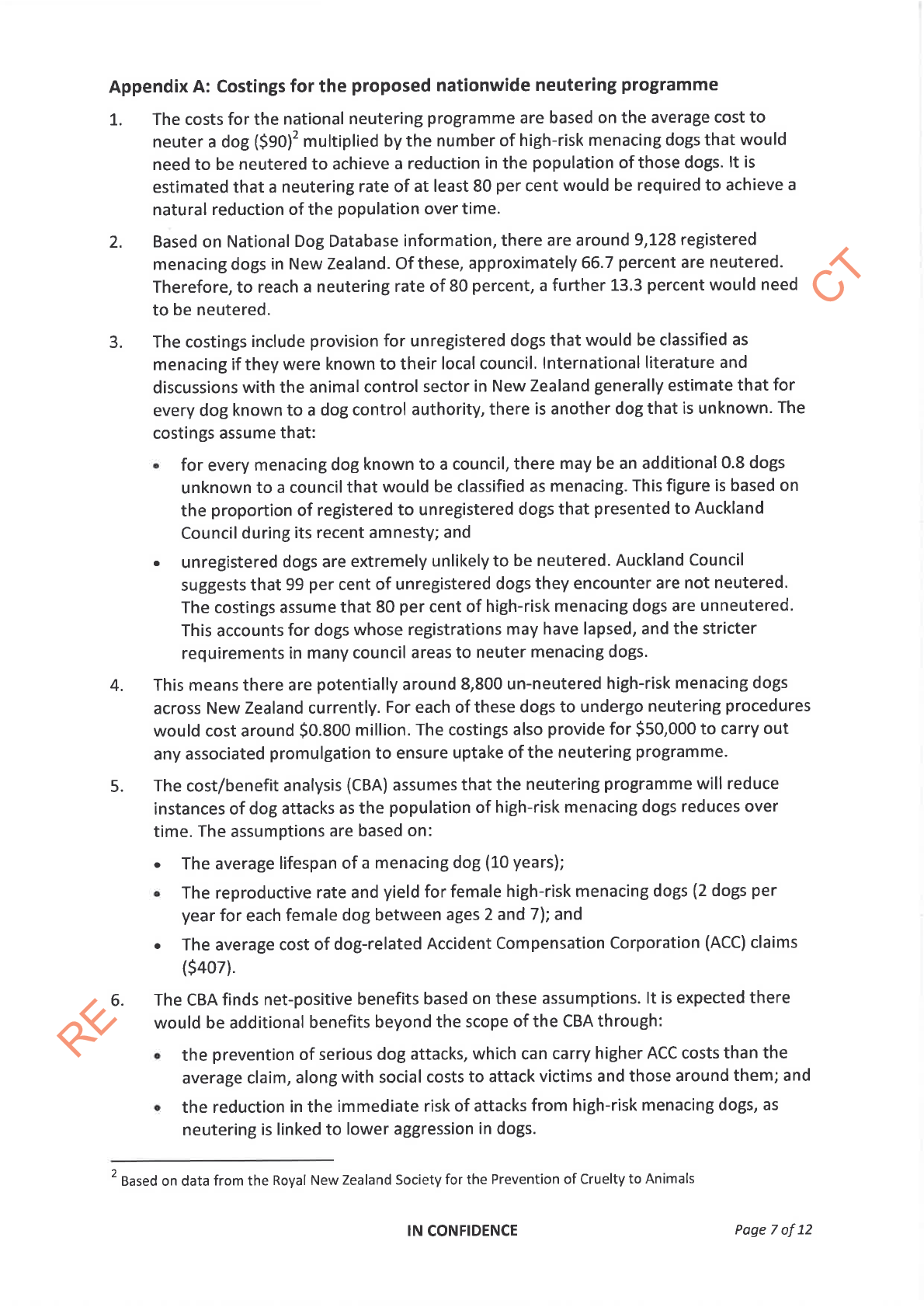
ACT
INFORMATION
RELEASED UNDER THE OFFICIAL
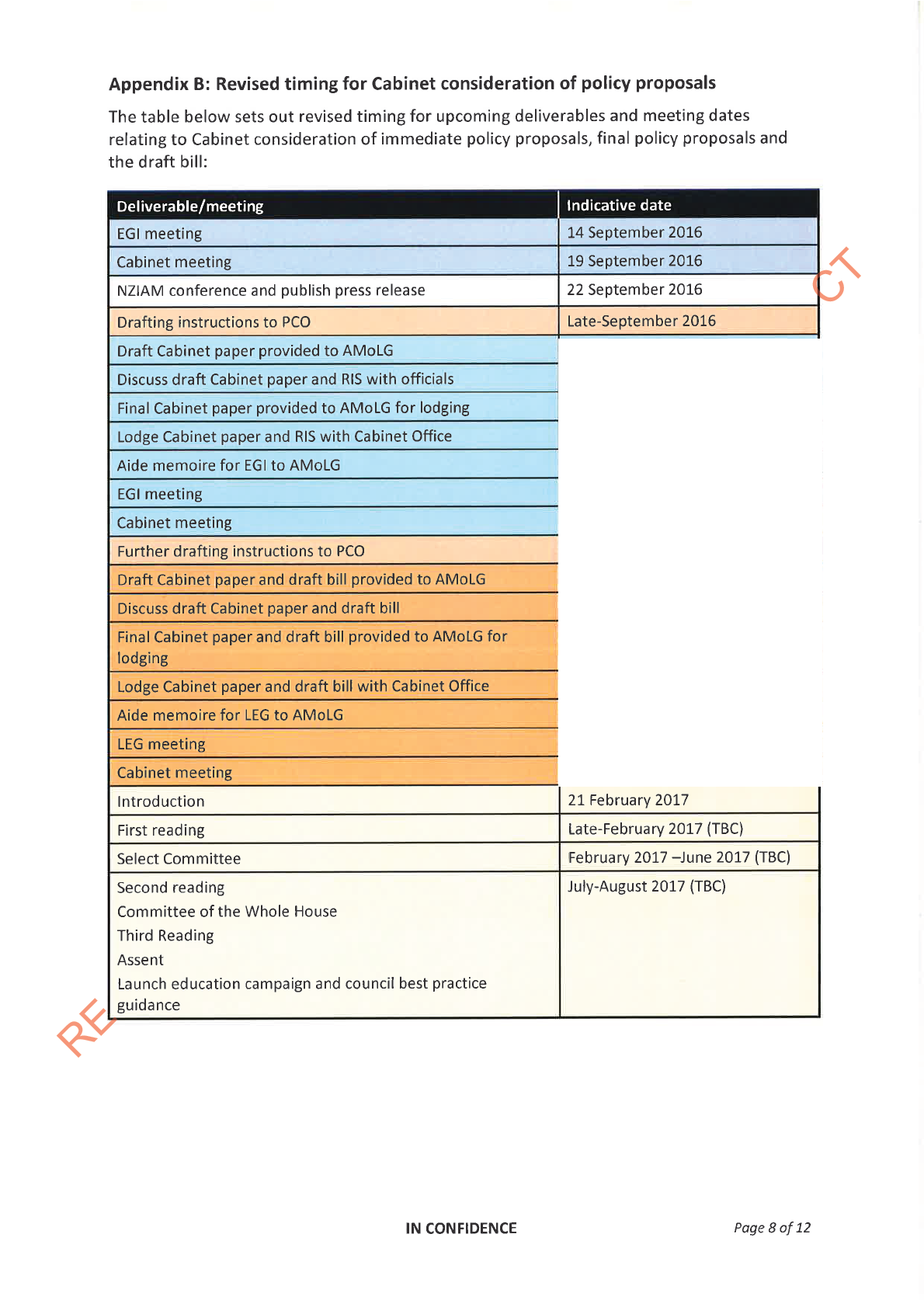
ACT
INFORMATION
s.9(2)(f)(iv)
RELEASED UNDER THE OFFICIAL
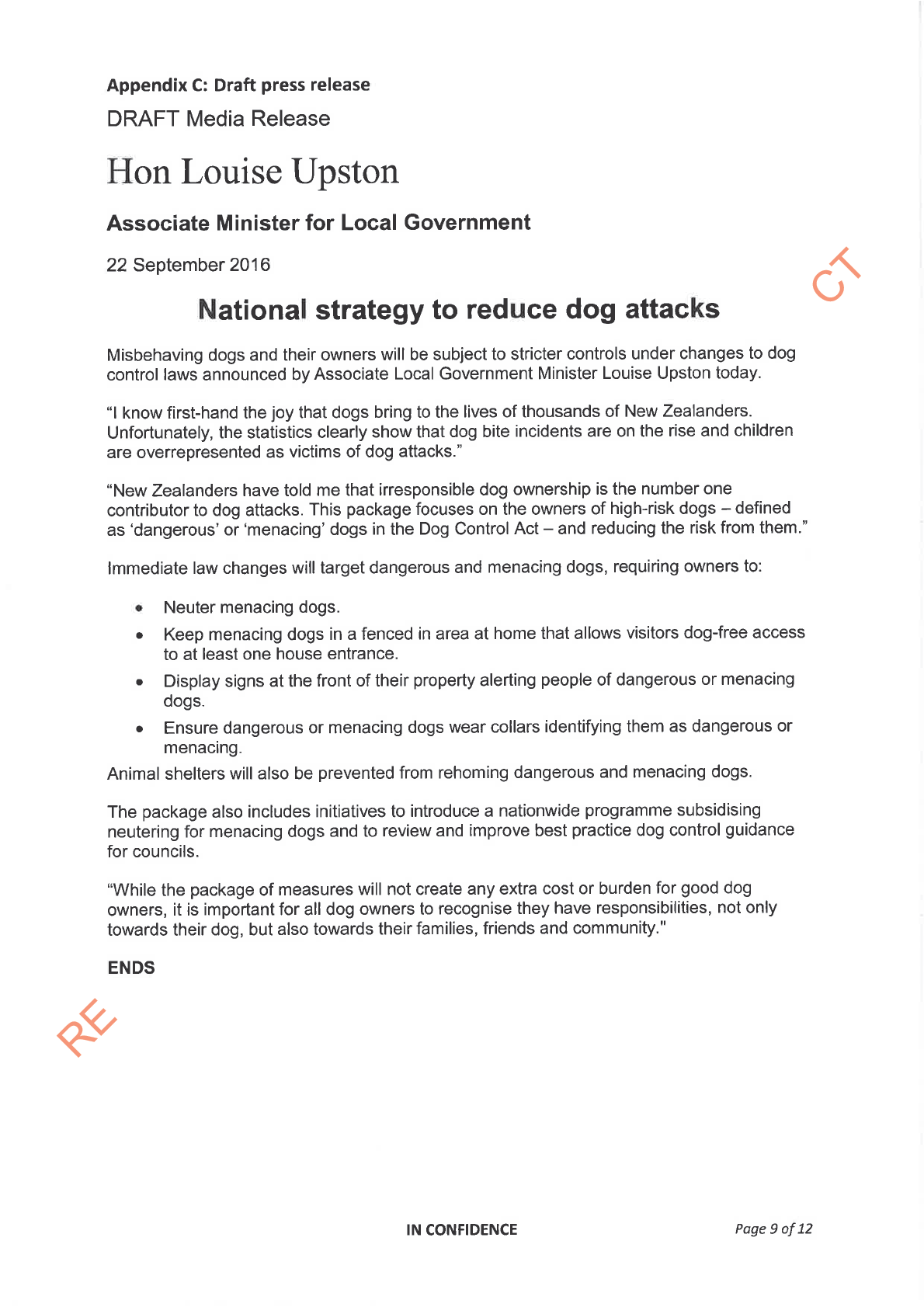
ACT
INFORMATION
RELEASED UNDER THE OFFICIAL
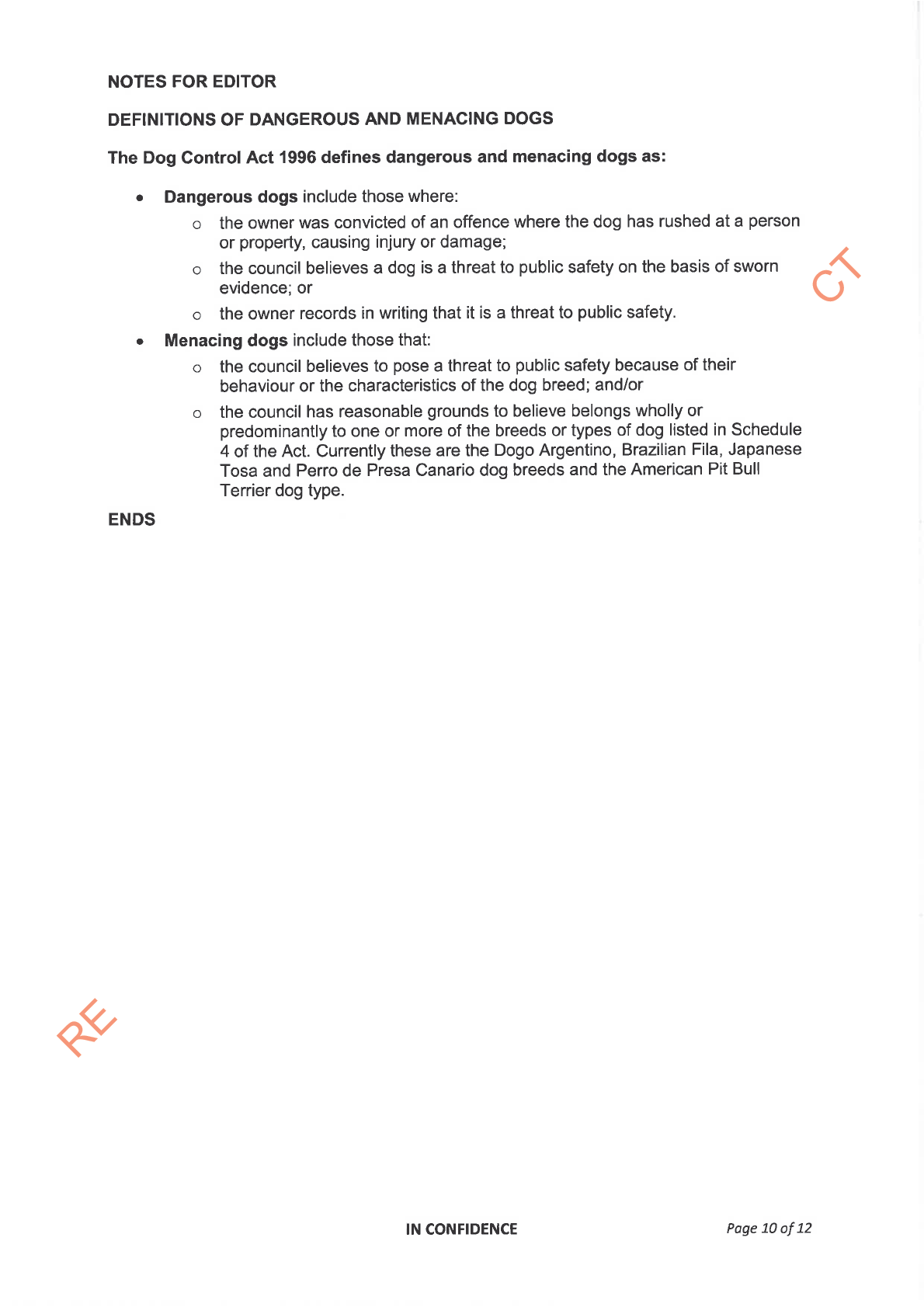
ACT
INFORMATION
RELEASED UNDER THE OFFICIAL
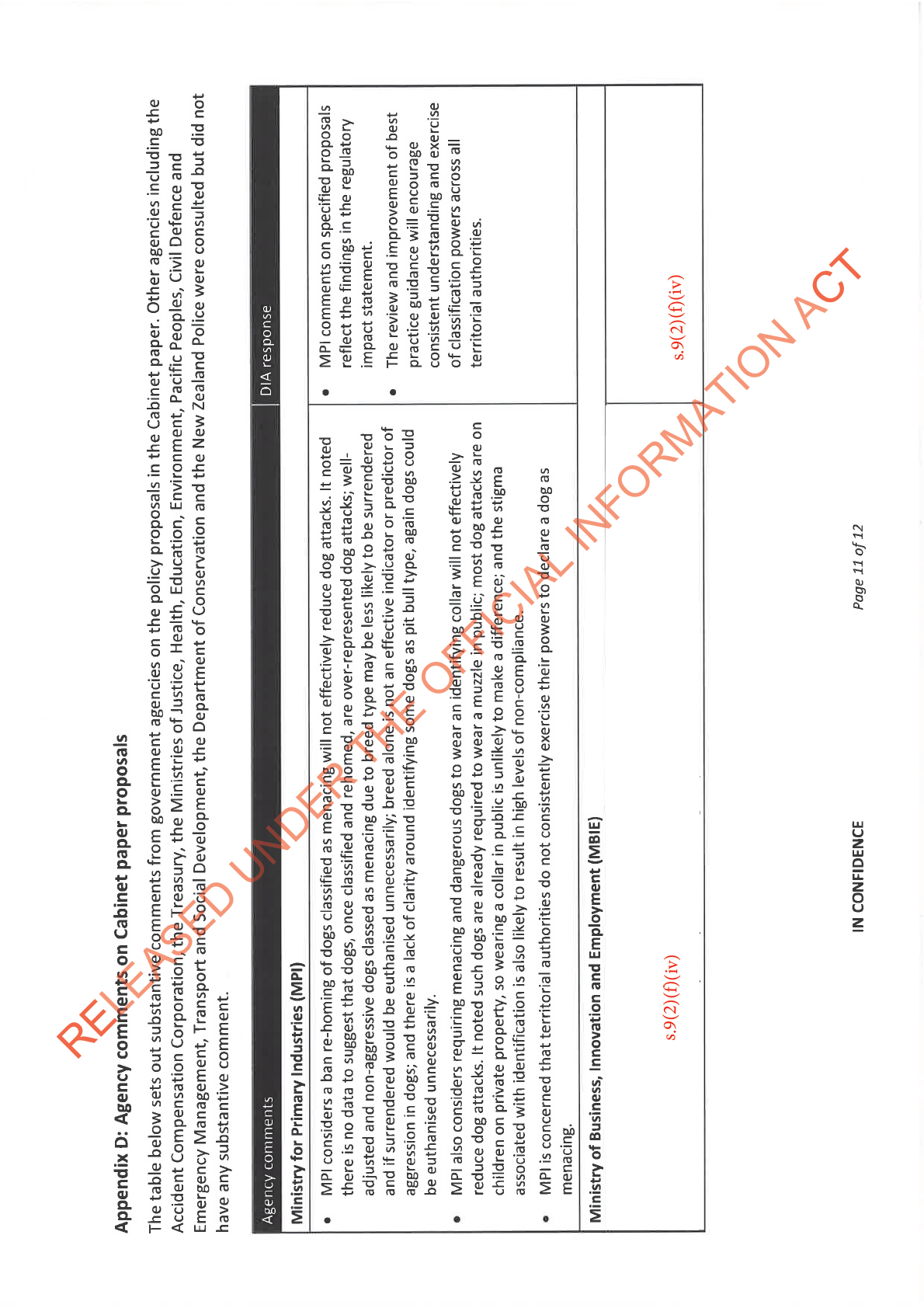
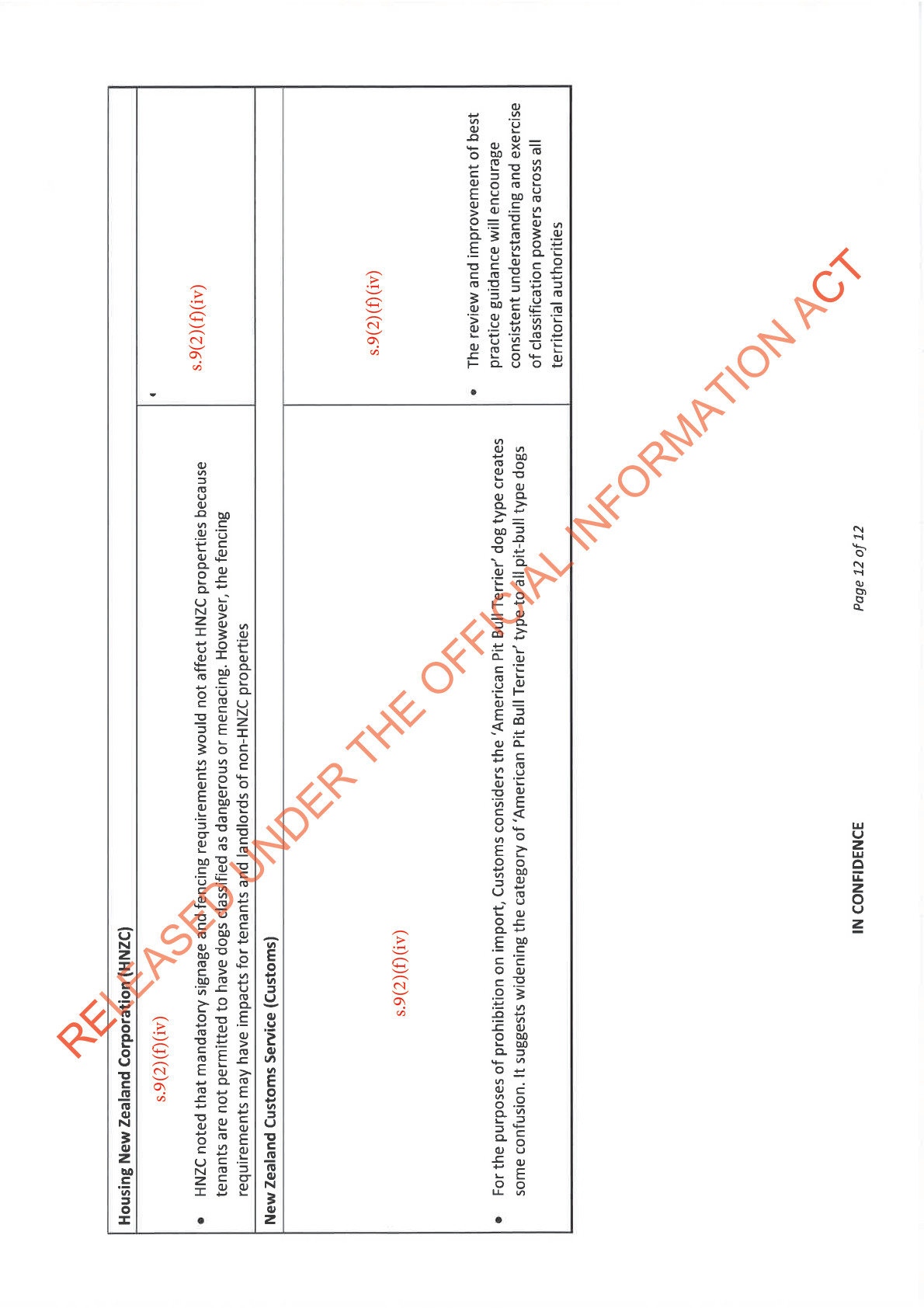
IN CONFIDENCE
Office of the Associate Minister of Local Government
Chair
Cabinet Economic Growth and Infrastructure Committee
National strategy to reduce the risk and harm of dog attacks
Proposal
1.
I propose Cabinet agree to the first tranche of a national strategy to reduce the risk
CT
and harm of dog attacks in New Zealand.
ACT
Executive summary
2.
Dogs play a valuable role in New Zealand society as pets, companions, assistance for
independent living, and as contributors to our economy. Though I recognise the
benefits of dog ownership, I am deeply concerned about data which indicates an
increasing number of dog attacks across the country.
3.
Our most vulnerable are more likely to be the victims of dog attacks. Accident
Compensation Corporation (ACC) data shows that children are disproportionately
represented in dog-related injury claims. Dog attacks are also more likely to happen in
INFORMATION
the home, which should be the safest place of all. Dog attacks create costs for society,
for the health system and for councils. Most importantly, there are immeasurable
costs associated with the trauma suffered by dog attack victims, their families and
their wider community.
4.
While I acknowledge that the majority of dog owners in New Zealand are responsible, I
consider it is time to take decisive action against the small number of irresponsible dog
owners who are causing so much harm. With this is mind, I am seeking Cabinet’s
approval of a national strategy to reduce the risk and harm of serious dog attacks.
5.
I have heard from a range of stakeholders and the public, and have considered many
options for change. The strategy I am proposing represents the ideas that will make
the most difference in terms of reducing the risk and harm of attacks, but impose the
smallest burden on responsible dog owners.
6.
Although I am outlining the overall strategy now, details of the policy decisions will be
split into two separate papers. I have separated the details of the proposals to allow
further consultation with the local government sector
s.9(2)(f)(iv)
7.
I am seeking Cabinet agreement to the first tranche of proposals in this paper, which
includes details for:
Legislative proposals
RE
RELEASED UNDER THE OFFICIAL
7.1
mandatory neutering of all menacing dogs;
7.2
a requirement that classified dogs be securely fenced within private property;
7.3
mandatory signage on properties with classified dogs;
7.4
requiring classified dogs to wear identification collars; and
7.5
prohibiting re-homing of classified dogs.
Page 1 of 16
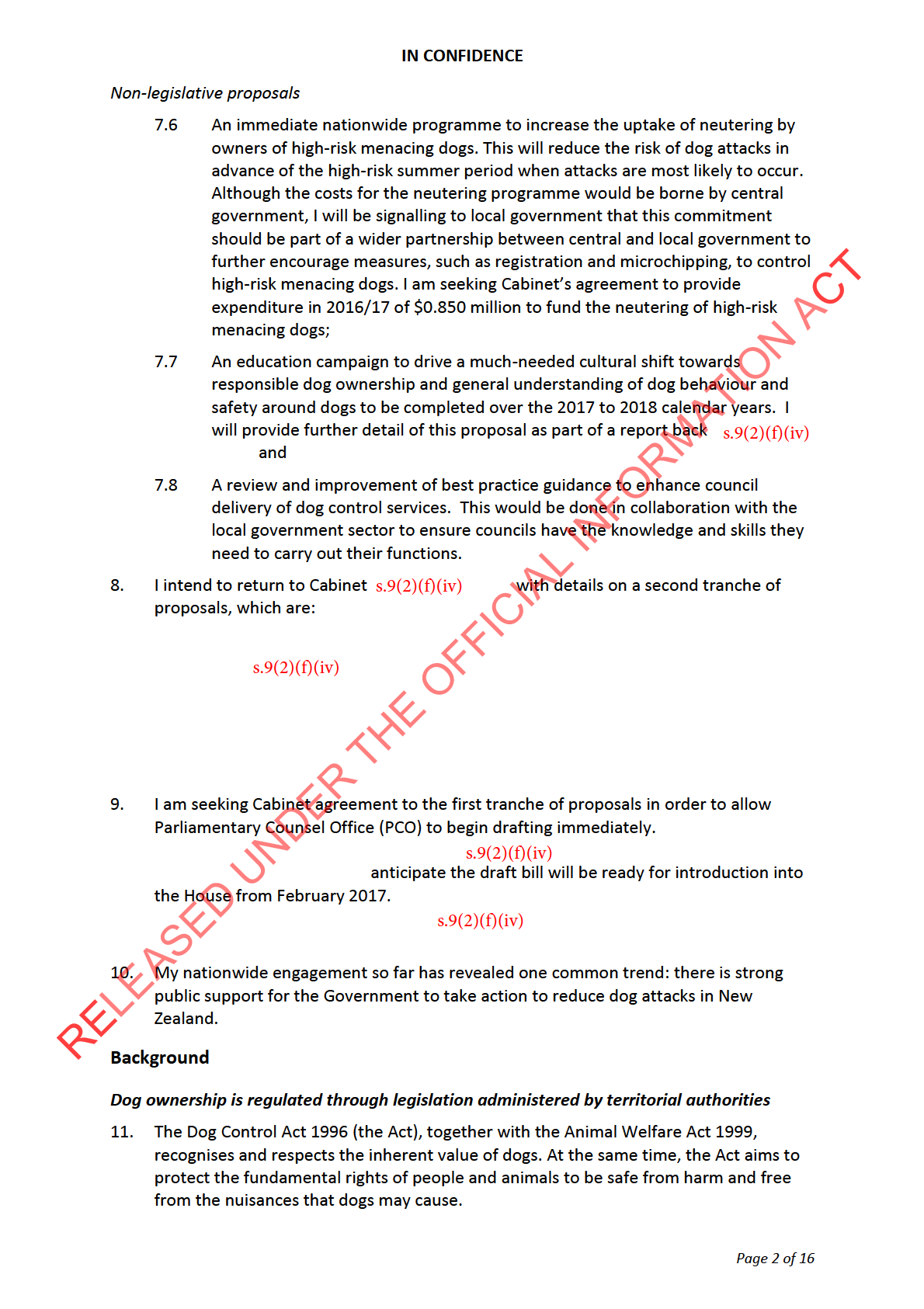
IN CONFIDENCE
12.
The Act was introduced following review of dog control in the mid-1990s, which found
that a serious dog control problem existed in New Zealand. Territorial authorities
implement the Act with the support of their communities.
13.
The current dog control regime sets out obligations for dog owners to meet the
welfare needs of their dog; keep their dog under control at all times; register and
microchip their dog; and ensure that their dog does not injure or threaten people or
animals.
14.
The Act also provides a wide range of powers and obligations for territorial authorities
in relation to registration, presence of dogs in public places, seizure, impounding and
CT
disposal of dogs, infringement, prosecution and regulation of dog owners. The Act
ACT
enables dog owners to appeal decisions by a territorial authority and its dog control
officers and dog rangers in respect of their dog and/or ability to own a dog.
Territorial authorities can classify individual dogs to impose greater controls on them
15.
The Act provides for the management of increased levels of risk associated with dogs
and dog owners by means of classification. Classification of dogs (as menacing or
dangerous) and of owners (as probationary or disqualified) allows for appropriate
controls to be put in place for the protection of the community.
16.
A territorial authority:
INFORMATION
must classify a dog as dangerous where an owner is convicted of an offence under
57A of the Act, or where, on the basis of sworn evidence, the council believes a dog
is a threat to public safety or where the owner records in writing that it is a threat
to public safety;
must classify a dog as menacing if there are reasonable grounds to believe it
belongs wholly or predominantly to one or more of the breeds or types of dog that
it is illegal to import into New Zealand (under Schedule 4 of the Act). There are four
listed
breeds (Dogo Argentino, Brazilian Fila, Japanese Tosa, Perro de Presa
Canario) and one
type (American Pit Bull Terrier); and
may classify a dog as menacing if it believes the dog poses a threat to public safety
because of its behaviour.
17.
Dogs classified as dangerous
must be kept in a fenced part of the owner's property,
must be muzzled and on a leash in public, and neutered. Dogs classified as menacing
must be muzzled in public, and councils
may require them to be neutered.
18.
For the purposes of this paper, a ‘high-risk dog’ is defined as either:
a high-risk menacing dog: any dog that has been classified as menacing under the
Act, including any dogs of breeds and types listed in Schedule 4 the Act, and any
dog that would be classified as menacing but has not yet been classified as it is not
registered; or
a high-risk dangerous dog: any dog that has been classified as dangerous under the
RE
RELEASED UNDER THE OFFICIAL
Act, and any dog that would be classified as dangerous but has not yet been
classified as it is not registered.
The Act has not been substantially changed since 2003
19.
The Act was amended substantially in 2003 to improve dog control and increase public
safety around dogs. The amendments introduced:
the ‘menacing dog’ classification;
Page 3 of 16
IN CONFIDENCE
additional enforcement powers for councils, including a power to restrict or
prohibit a person from dog ownership;
additional responsibilities for dog owners (particularly for owners of classified
dogs);
requirements to microchip dogs; and
include a requirement for councils to report annually to the Secretary for Local
Government.1
20.
Aside from a 2012 amendment which introduced a regime for the certification of
Disability Assist Dogs and other minor amendments, the dog control regime has not
CT
ACT
been significantly changed since 2003.
The problem: data indicates serious dog attacks have not reduced
21.
Despite the 2003 improvements to the regime, serious dog attacks continue to occur.
Ministry of Health data shows the number of dog bite patients discha ged from
hospital per year has increased by 58 per cent, from 457 in 2005 to 724 in 2015. The
number of active ACC claims for dog-related injuries also continues to steadily
increase, from 10,196 in 2006 to 12,695 in 2015. The average cost of these claims in
2015 was $407 per claim. However, this figure is skewed by the large number of minor
dog-related injuries. What I am interested in addressing is the most serious dog
INFORMATION
attacks that require rehabilitative treatment over multiple years. ACC has noted that
from 2011 to 2015, the average total cost for the top five most expensive dog-related
claims was $252,923.
22.
Our children are more likely to be victims of dog attacks. Data from the University of
Otago Injury Prevention Unit about dog related incidents shows that almost 30 per
cent of patients from 2000 to 2014 were children under the age of ten. Plastic
surgeons confirm that children are more vulnerable to serious injuries due to their size
when compared to an average sized dog.
23.
ACC data shows almost 60 per cent of dog-related injury claims were for incidents that
occurred at home, and over 10 per cent occurred on a street or highway. The risk of
attack can interfere with an individual’s sense of safety at home and sense of freedom
in public.
There are also problems with the current dog control regime
24.
There are a number of areas in the current regulatory framework for dog control that
present challenges to understanding and controlling the current population of dogs:
New Zealand has a large number of unregistered dogs, and those unregistered
dogs are over-represented in impounds and attacks. This alone makes it difficult to
place controls on dogs that require them;
RE
RELEASED UNDER THE OFFICIAL
1 Cabinet recently agreed to amend this reporting requirement by way of a local government omnibus bill. The
change will require councils to publish their annual dog control reports on their websites, instead of reporting
to the Secretary for Local Government [CAB-16-MIN-0338 refers].
Page 4 of 16
IN CONFIDENCE
purebred American Pit-Bull Terrier dogs2 represent around 0.04 percent of the
total registered dog population, but pit-bull type dogs make up a
disproportionately high number of impounded dogs. In South Auckland alone, pit-
bull type dogs (including pit-bull cross breeds) made up 37 per cent of impounded
dogs in 2014/15;
there are issues with classifying dogs as menacing based on breed or type, with
significant variation in how councils determine a dog to be menacing; and
all dogs have the potential to attack. Conflicting messages about correct
socialisation of dogs and managing dog behaviour, from councils, breeders,
CT
trainers, veterinarians, pet shops, animal welfare and rescue organisations and
ACT
other interested parties, creates confusion among dog owners and members of the
public and increases the potential for non-compliance.
25.
These issues increase the latent risk for dog attacks and serious harm to occur. It is
difficult for a council to control a dog population that it cannot easily locate or
accurately quantify. The potential overrepresentation of high-risk dogs in the
unregistered dog population creates a barrier to preventing the most serious dog
attacks. Additionally, with incomplete knowledge about the dog population, it is
challenging to develop interventions that will be effective in reducing the risk and
harm of dog attacks.
INFORMATION
New Zealanders want changes to the dog control regime to reduce the risk and harm of
dog attacks
26.
I have engaged with Mayors, local authorities and interested organisations such as
Local Government New Zealand, the New Zealand Veterinary Association, Federated
Farmers of New Zealand, the Royal New Zealand Society for the Prevention of Cruelty
to Animals and numerous other groups. I have also personally spoken with victims of
dog attacks, animal control officers, dog behaviour experts and others with first-hand
experience of dog control issues.
27.
Public concern about dog attacks was highlighted in the overwhelming response to the
online survey I launched in August this year about reducing dog attacks. The survey
attracted over 3000 responses in the two-week period. Respondents consistently
identified irresponsible dog owners and poor education about dog behaviour as the
two biggest contributing factors to dog attacks. This feedback has shaped policy
development and informed my final proposed approach.
28.
Although I acknowledge that dog ownership has many benefits, the present risk of a
person or animal being subject to a dog attack, and the level of harm caused by serious
dog attacks, is unacceptable to New Zealanders.
I propose a national strategy to reduce the risk and harm of dog attacks
29.
The proposed national strategy will be led by central and local government. The
proposed legislative amendments will place stronger controls on high-risk dogs and
RE
RELEASED UNDER THE OFFICIAL
their owners to reduce the risk and harm of dog attacks, signalling this Government’s
intolerance for the risk these groups currently present. These proposals will also assist
in moving New Zealand towards a lower risk dog population.
2 Note the American Pit Bull Terrier type is listed under Schedule 4 of the Act, which bans them from
importation and requires territorial authorities to classify them as menacing.
Page 5 of 16
IN CONFIDENCE
30.
However, I acknowledge that legislative change alone will not be sufficient to achieve
these goals. I therefore also propose three additional supporting measures:
an immediate nationwide programme of neutering for all high-risk menacing dogs,
with the costs borne by central government;
an education campaign to promote a cultural shift towards responsible dog
ownership and safety around dogs to take place in 2017 and 2018; and
best practice guidance to assist councils in their delivery of dog control services
nationwide, to be produced in collaboration with Local Government New Zealand.
CT
31.
Together, I anticipate that my proposals will see an initial increase in the number of
ACT
classified dogs as more dogs will be identified and classified, but there will be an
eventual decrease in the numbers of those dogs in the population.
Overview of legislative proposals targeting high-risk dogs and high-risk owners
32.
Although I am seeking Cabinet approval of the overall strategy now, details of the
policy decisions will be split into two separate papers. I have separated the details of
the proposals to allow further consultation with the local government sector to ensure
a proposed licensing system can operate effectively, and ensure that territorial
authorities have the right enforcement tools to carry out their responsibilities under
the Act.
INFORMATION
33.
My proposed legislative changes are:
mandatory neutering of all menacing dogs;
a requirement that classified dogs be securely fenced within private property;
mandatory signage on properties wi h classified dogs;
requiring classified dogs to wear identification collars; and
prohibiting re-homing of classified dogs.
34.
Details of the proposals are provided below.
Requiring all menacing dogs to be neutered will reduce aggression and help move New
Zealand to a lower-risk dog population
35.
Approximately two-thirds of councils currently require dogs that have been classified
as menacing to be neutered. Where such a policy is adopted, a non-compliant owner
can be fined (upon conviction) and the territorial authority can seize the dog and retain
it until the owner is willing to comply, or dispose of the dog.
36.
I propose that all dogs classified as menacing be neutered, and the discretion for
councils to adopt varying policies on the matter be removed from the Act. Dogs will be
required to be neutered at the point of classification.
37.
According to veterinarians and dog behaviour specialists, neutering is linked to lower
aggression in individual dogs. In the short term, neutering may aid improvement in the
RE
RELEASED UNDER THE OFFICIAL
behaviour of the individual animal. Over the longer term, there would be a smaller
pool of unneutered dogs belonging to the breeds and types listed on Schedule 4 of the
Act. There would also be fewer dogs inheriting menacing behavioural traits.
38.
This proposal will be supported by the temporary nationwide subsidy of neutering fees
for high-risk menacing dogs (discussed below under non-legislative measures).
Page 6 of 16
IN CONFIDENCE
Requiring menacing dogs to be securely fenced will increase safety on private property
39.
Under section 32(1)(a), owners of dogs that have been classified as dangerous are
required to keep their dog within a securely fenced portion of their property that it is
not necessary to enter to obtain access to at least one door of any dwelling on the
property.
40.
I propose to amend the Act to extend the requirement to owners of dogs classified as
menacing. At the point of classification, councils would have to inspect the property to
determine compliance, and the dog would not be returned to the owner until they
were compliant. Owners of dogs classified as menacing that do not meet these
CT
obligations would have their menacing dog seized.
ACT
41.
This will reduce encounters between visitors and classified dogs on private property,
where ACC data shows 60 per cent of all dog-related injuries occur. Additionally, it will
reduce the likelihood that those dogs will roam/run off from the property when
provoked, and prevent them from becoming agitated from other containment
methods, such as chaining.
Requiring owners of classified dogs to display warning signs on their property will allow
visitors to be aware of potential risks
42.
Similar to the above proposal to securely fence menacing dogs, this proposal promotes
INFORMATION
safety on private properties. The owner would be required to pay the council for the
sign, which would carry a warning and display the dog’s classification.
43.
My conversations with victims of dog attacks revealed that people often do not know
when they may be entering a high-risk situation. This type of visual warning will allow
visitors to be informed of the potential risk and act accordingly.
Requiring classified dogs to wear identification collars will assist the public in behaving
appropriately around them
44.
Under section 32(1)(b)(i) and section 33E(1)(a), owners of dogs classified as dangerous
or menacing must not allow their dog to be at large in any public place or private way
without being muzzled
45.
I propose a requirement for dogs to wear collars that would identify them as menacing
or dangerous dogs. Councils would issue these collars at a cost to the owner. While
muzzles are an indicator that a dog may be classified as menacing or dangerous, a
collar would make the classification clearer to people who may encounter the dog on
private property and/or in public places. Allowing the public to visually identify high-
risk dogs would enable them to tailor their interaction appropriately, reducing the
likelihood of an attack. s.9(2)(f)(iv)
Prohibiting the re-homing of classified dogs will help move New Zealand to a lower-risk dog
RE
RELEASED UNDER THE OFFICIAL
population
46.
Many territorial authorities have a policy of prohibiting the rehoming of menacing or
dangerous dogs from their shelters. I propose that this be made a nationwide
requirement. Territorial authorities could still return the classified dog to their original
owner if they are compliant with the requirements for owning a classified dog.
However, if the original owner cannot be identified, the dog will be destroyed rather
than re-homed.
Page 7 of 16
IN CONFIDENCE
47.
This proposal would significantly reduce the number of classified dogs in the current
population.
Overview of non-legislative proposals to support legislative change
An immediate nationwide neutering programme for owners of high-risk menacing dogs will
support the overall strategy
48.
To underpin the strategy, I propose a nationwide programme to neuter high-risk
menacing dogs, to take effect from October 2016, running until October 2017. This
will:
CT
ACT
ensure more high-risk menacing dogs are neutered; and
reduce the overall supply of those dogs in the long-term.
49.
A long-term overall reduction in the number of classified dogs will also support
enforcement practises, as currently it can be easier to obtain a new dog rather than
comply with council restrictions.
50.
Allowing the programme to take effect immediately will ensure that the Government
has taken direct action in advance of the high-risk summer period when dog attacks
are most likely to occur3. Neutering lowers the chance of attack as it has been linked to
reduced aggression and decreased roaming. It will also raise public awareness of the
INFORMATION
proposals over summer and give this work momentum
51.
Some members of the public may react negatively to the proposed requirement that
all menacing dogs be neutered given the potential financial costs. The proposed
temporary subsidy will mitigate that negative reaction, and provide owners of high-risk
menacing dogs with a strong incentive to have their dogs neutered prior to the
practice becoming mandatory.
52.
Owners that come forward to have their dog neutered are also likely to, in turn,
register their dog with their council. This secondary benefit of increased registration
will also address one of the biggest challenges for dog control in New Zealand –
preventing dog attacks by the vast numbers of unregistered dogs that are unknown to
territorial authorities. Without knowledge of where potentially dangerous dogs are,
territorial authorities are powerless to take preventive action and can only intervene
when an attack has occurred and the damage has been done. Additionally, any
regulatory measures that the Government might take can only be effective if owners
have registered their dogs.
53.
An increase in the number of registered and classified dogs would support the
proposed measures specially targeting those groups, such as owner licensing and
signage/fencing requirements, by extending the ‘reach’ of those restrictions to a
greater number of owners.
54.
Given the wide-ranging benefits of the neutering programme, I propose that central
government provide the funding. I am therefore seeking Cabinet’s agreement to
RE
RELEASED UNDER THE OFFICIAL
provide expenditure in 2016/17 of $0.850 million to establish the required fund.
s.9(2)(f)(iv)
3 Data from the University of Otago Injury Prevention Unit for the period 1 July 1999 to 30 June 2014
Page 8 of 16
IN CONFIDENCE
55.
Although central government would provide the funding by way of a subsidy towards
neutering costs, I expect that the local government sector will take the opportunity to
support the initiative and get more dogs into the registration system. This could
include providing similar financial incentives for other dog control services, such as
registration fees and microchipping. This will essentially create a joint central and local
government approach for increasing neutering and registration nationwide.
56.
Auckland Council ran a similar 10-week amnesty this year with considerable success,
resulting in around 1500 unregistered dogs being brought forward for registration,
microchipping and neutering.
CT
57.
Overall, this programme will send a strong signal that the Government is setting clear ACT
expectations around dog ownership and will prepare the public.
Education about responsible dog ownership and safety around dogs will support the
legislative changes and lead to cultural change (2017-2018 calendar years)
58.
Responses to my recent online engagement survey on reducing dog attacks indicated
strong public support for nationwide education. The vast majority of respondents
identified education about dog behaviour for dog owners and the general public as a
key tool to reduce dog attacks.
59.
I propose an education campaign which will be led by central government and either in
INFORMATION
partnership with, or supported by, local government, with input from non-government
organisations. The campaign would begin following the passage of the legislative
changes, and continue for up to 12 months, to:
inform owners about their new responsibilities (immediately following the
legislative changes); and
promote responsible dog ownership by normalising appropriate behaviour, and
improving the ability of adults and children to interact safely with dogs (long-term
cultural shift).
60.
Further details on this proposal will be outlined s.9(2)(f)(iv)
The Local Government Sector will produce best practice guidance to improve council delivery
of dog control services (2017-2018 calendar years)
61.
While I acknowledge that irresponsible dog owners are generally the biggest
contributing factor to dog attacks, territorial authorities have a key role to play in the
administration of the dog control regime.
62.
Local Government New Zealand has agreed to work with central government to
produce best practise guidance for territorial authorities’ administration of the dog
control regime. Existing guidance materials published by the Department of Internal
Affairs and legal compliance modules produced by the Society of Local Government
Managers may be redeveloped or replaced, in light of best practice in dog control from
around New Zealand and overseas jurisdictions.
RE
RELEASED UNDER THE OFFICIAL
63.
This may include guidance centred around the proposed legislative changes, and
implementation of the Act more generally, such as ways to:
increase uptake of registration, neutering, and micro-chipping;
promote responsible dog ownership; and
improve information-sharing and enforcement (including identifying breeds for
classification as menacing).
Page 9 of 16
IN CONFIDENCE
64.
I anticipate that this guidance would be launched in 2017 following the legislative
changes.
Proposals for which I will seek agreement
CT
ACT
s.9(2)(f)(iv)
INFORMATION
Consultation
70.
This paper was prepared by the Department of Internal Affairs. The following agencies
were provided draft versions of this paper for consultation: The Treasury, the Accident
Compensation Corporation, the Ministries of Justice, Health, Education, Primary
Industries, Pacific Peoples, Social Development, Civil Defence and Emergency
Management, Business, Innovation and Employment, Te Puni Kōkiri, the Department
RE
RELEASED UNDER THE OFFICIAL
of Conservation, the Office for Disability Issues, New Zealand Police, New Zealand
Customs Service and Housing New Zealand Corporation. The Department of the Prime
Minister and Cabinet has been informed.
Page 10 of 16
IN CONFIDENCE
71.
In the preparation of the proposed strategy, a wide range of external stakeholders
were also consulted, including the Society of Local Government Managers and Local
Government New Zealand, Auckland Council, the New Zealand Institute of Animal
Management (previously known as the New Zealand Institute of Animal Control
Officers), the New Zealand Association of Plastic Surgeons, the New Zealand Kennel
Club, Federated Farmers of New Zealand, Rural Women New Zealand, the Veterinary
Council of New Zealand, dog behaviour experts, TradeMe, and the Royal New Zealand
Society for the Prevention of Cruelty to Animals.
72.
I have personally met with victims of dog attacks, farmers and other members of the
CT
rural community and animal control officers. Additionally, an online engagement
ACT
survey was used to capture the sentiment of the general public about areas for
improvement to the dog control regime. The two-week survey period resulted in over
3000 responses.
73.
The Minister of Local Government has agreed to the submission of this paper in
accordance with the delegation to the Associate Minister of Local Government on
matters relating to dog control.
Financial implications
74.
I seek Cabinet’s agreement to provide expenditure in 2016/17 of $0.850 million to
establish a fund to subsidise the neutering of high-risk menacing dogs and to provide
INFORMATION
for the associated promulgation.
75.
s.9(2)(f)(iv)
Human rights, gender and disability perspective
77.
There are no human rights or gender implications arising from the proposals in this
paper. There are also no implications from a disability perspective. The proposals do
not change the settings for certification or ownership of Disability Assist Dogs.
Legislative implications
78.
I seek agreement to implement the policy proposals in this paper in a bill to amend the
Dog Control Act 1996. I am seeking approval to include such a bill on the 2016
Legislative Programme.
RE
RELEASED UNDER THE OFFICIAL
79.
I also seek authority to issue drafting instructions for that bill, and to make any
adjustments to policy decisions consistent with the overall policy intent that are
revealed to be necessary during the drafting process.
80.
I also intend to develop further policy proposals for inclusion in the bill
s.9(2)(f)(iv)
.
Page 11 of 16
IN CONFIDENCE
81.
I anticipate the draft bill will be ready for introduction into the House from February
2017.
Regulatory impact analysis
82.
The regulatory impact analysis requirements apply to the proposals outlined in this
paper. The Chair of the Department’s Regulatory Impact Analysis Panel has reviewed
the regulatory impact statement (RIS) prepared by the Department and considers that
the information and analysis summarised in the RIS partially meets the quality
assurance criteria. The Chair considers that although the RIS is comprehensive and
contains a robust analysis, options cannot be fully assessed due to a lack of reliable
CT
evidence.
ACT
83.
I note the Chair’s comments around the lack of reliable evidence. I intend to look into
ways to better collect information on dog attacks, s.9(2)(f)(iv)
Publicity
84.
Subject to Cabinet approval, I intend to announce the decision to progress the national
strategy at the annual conference of the New Zealand Institute of Animal
Management, which will take place on 22 September 2016 I will issue a media release
the following day and wish to proactively release this Cabinet paper and associated
INFORMATION
minutes. Officials at the Department will advise key consulted stakeholders of
decisions prior to the media release.
Recommendations
85.
The Associate Minister of Local Government recommends that the Cabinet Economic
Growth and Infrastructure Committee:
1.
note that the central objective of dog control policy in New Zealand is to strike
an appropriate balance between the advantages to individuals and communities
of dog ownership and the protection of individuals and communities from dog
attacks;
2.
note that the Associate Minister considers that the current settings of the Dog
Control Act 1996 do not maximise the ability to achieve both these objectives to
the extent possible;
3.
note the Associate Minister’s proposal to progress a national strategy comprising
of both legislative and non-legislative measures to reduce the risk and harm of
dog attacks in New Zealand;
Legislative measures
4.
agree to include a Dog Control Amendment Bill on the 2016 Legislation
Programme with a category 6 (drafting instructions to be issued to Parliamentary
Counsel in 2016);
RE
RELEASED UNDER THE OFFICIAL
5.
note that:
5.1
it is expected that the Bill will be introduced in February 2017;
5.2
the Associate Minister of Local Government will seek a category 3 priority
on the 2017 Legislation Programme (to be passed in 2017 if possible) at
the appropriate time;
Page 12 of 16
IN CONFIDENCE
6.
agree that the bill would:
6.1
require all dogs classified as menacing to be neutered;
6.2
require dogs classified as menacing to be securely fenced within private
property;
6.3
require mandatory signage on properties with menacing and dangerous
dogs;
6.4
require dogs classified as menacing and dangerous to wear identification
collars;
CT
6.5
prohibit the re-homing of menacing and dangerous dogs;
ACT
7.
invite the Associate Minister to issue drafting instructions to the Parliamentary
Counsel Office in accordance with recommendations 6.1-6.5 above;
8.
authorise the Associate Minister to make decisions on any subsequent minor
issues arising from legislative drafting that align with the overall policy intent;
Non-legislative measures
9.
note that for the legislative proposals to be fully effective in reducing the risk and
harm of dog attacks, non-legislative measures are required before and alongside
changes to the Dog Control Act 1996;
INFORMATION
10.
note that compliance with the proposed legislative measures will create resource
implications for local authorities and owners of high-risk dogs, while producing
significant public benefit through the reduced risk and harm of dog attacks;
11.
agree to fund a nationwide subsidy of neutering fees for high-risk menacing
dogs, which would take effect immediately ahead of legislative changes to the
Dog Control Act 1996 to:
11.1 lower aggression in the high-risk menacing dog population in the short-
term, decreasing the immediate harm caused by dog attacks;
11.2 reduce the supply of high-risk menacing dogs over the long-term,
lowering the prevalence of dog attacks;
11.3 encourage the uptake of regulatory compliance among the owners of
high-risk menacing dogs, in order to successfully target future initiatives;
12.
note that the local government sector will proceed with a review of best practice
guidance in dog control for territorial authorities, to improve the delivery of
services based on the most recent local and international evidence;
RE
RELEASED UNDER THE OFFICIAL
Page 13 of 16
IN CONFIDENCE
Financial recommendations
s.9(2)(f)(iv)
13.
CT
ACT
INFORMATION
s.9(2)(f)(iv)
RE
RELEASED UNDER THE OFFICIAL
Page 14 of 16


ACT
INFORMATION
s.9(2)(f)(iv)
RELEASED UNDER THE OFFICIAL

The Department of Internal Affairs
Te Tari Taiwhenua
Local Government New Zealand is reviewing best practice guidance to enhance council
delivery of dog control services. This will be launched following legislative change.
When will the Associate Minister be announcing the National Strategy?
The Associate Minister will announce the National Strategy at the New Zealand Institute
of Animal Management conference on 22 September 2016. She will only announce the
first tranche of changes. The further proposals to be considered by Cabinet in November
will be announced at a later date.
Was there a strong evidence base for the proposed changes?
CT
ACT
The data supporting the policy proposals is limited. However, there is a need for
immediate action to reduce the risk and harm of serious dog attacks.
N
s.9(2)(f)(iv)
INFORMATION
A
FF
D UNDER T
REL
RELEASED UNDER THE OFFICIAL
Page 2 of 2
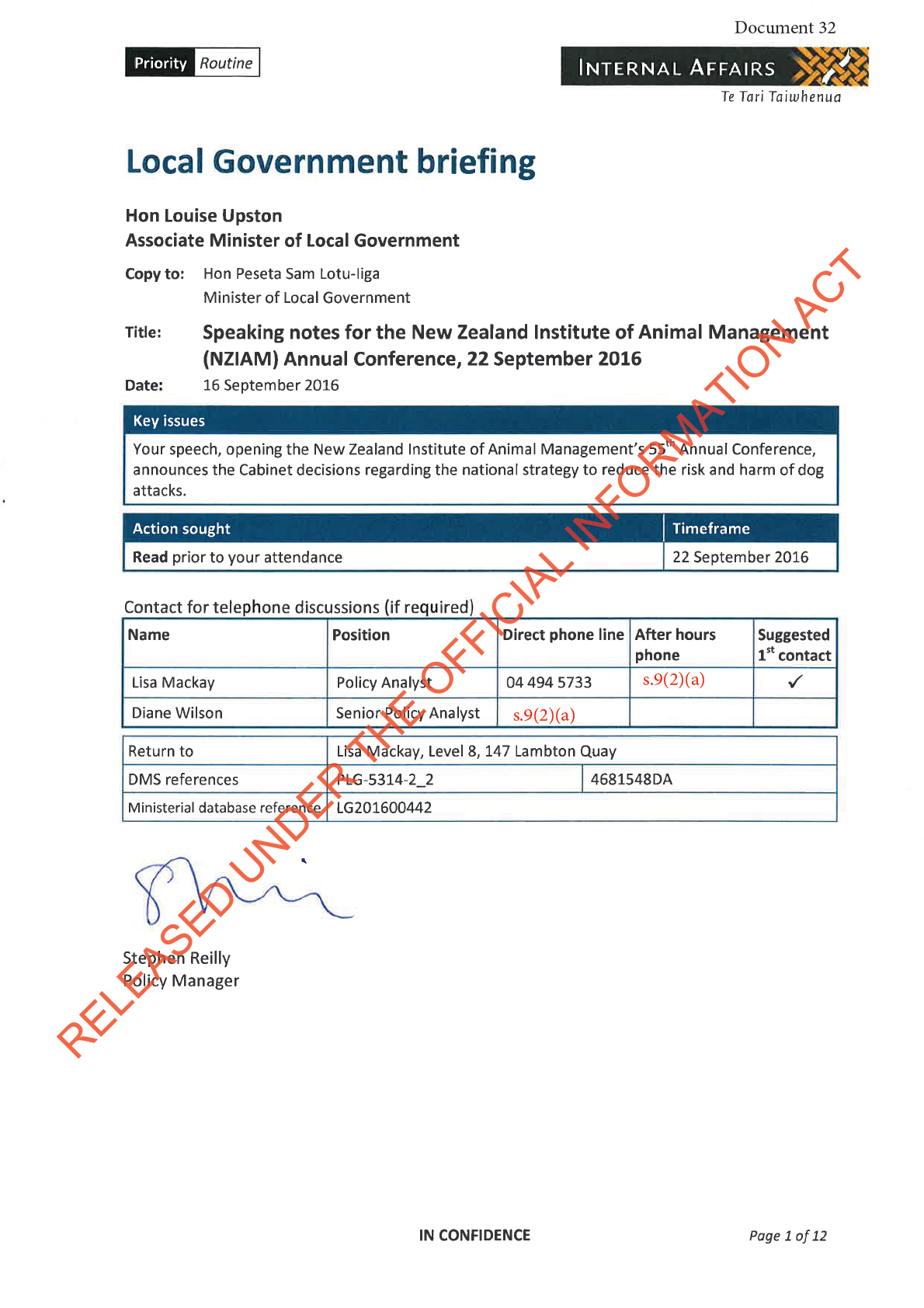
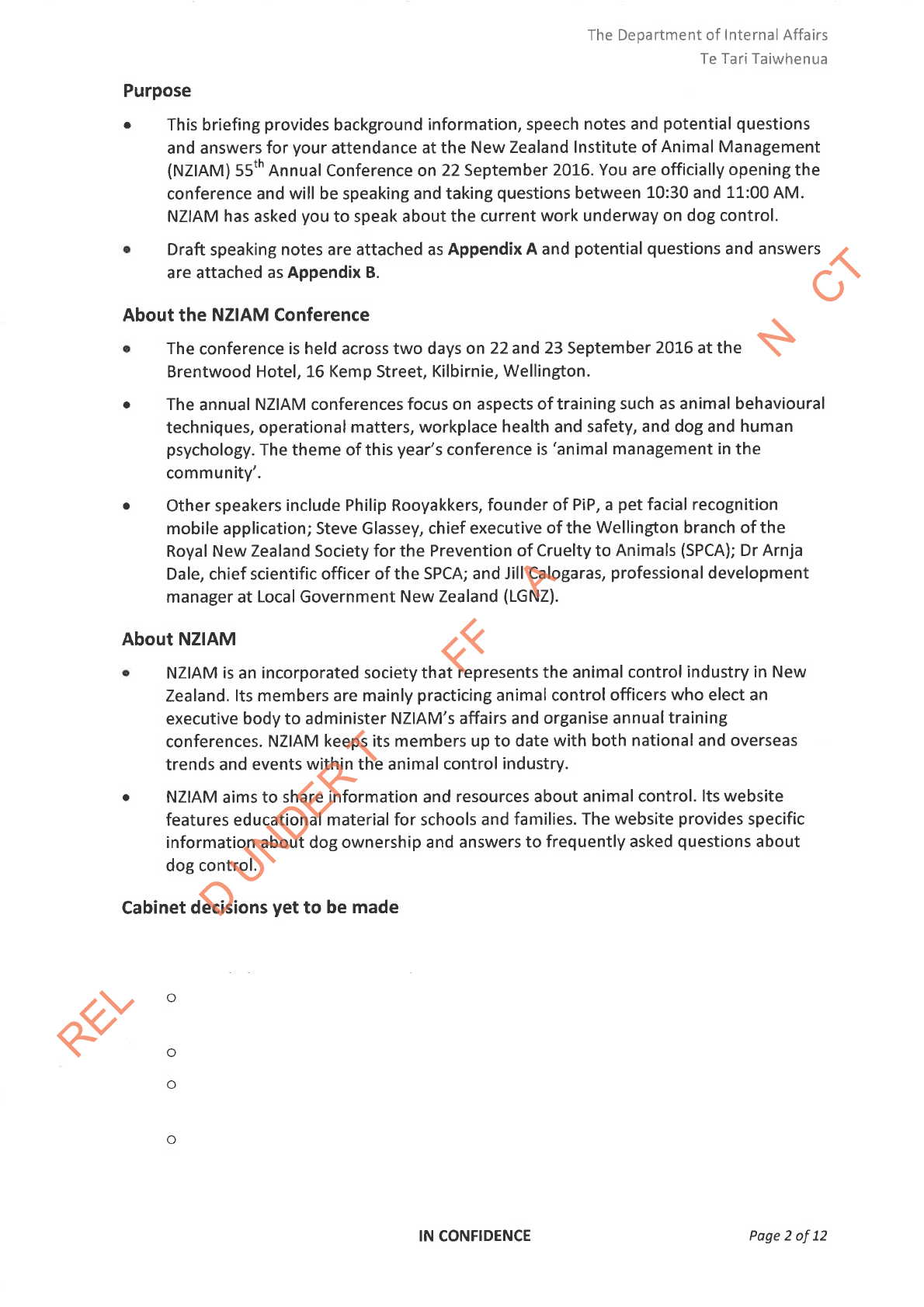
ACT
INFORMATION
s.9(2)(f)(iv)
RELEASED UNDER THE OFFICIAL

ACT
INFORMATION
RELEASED UNDER THE OFFICIAL
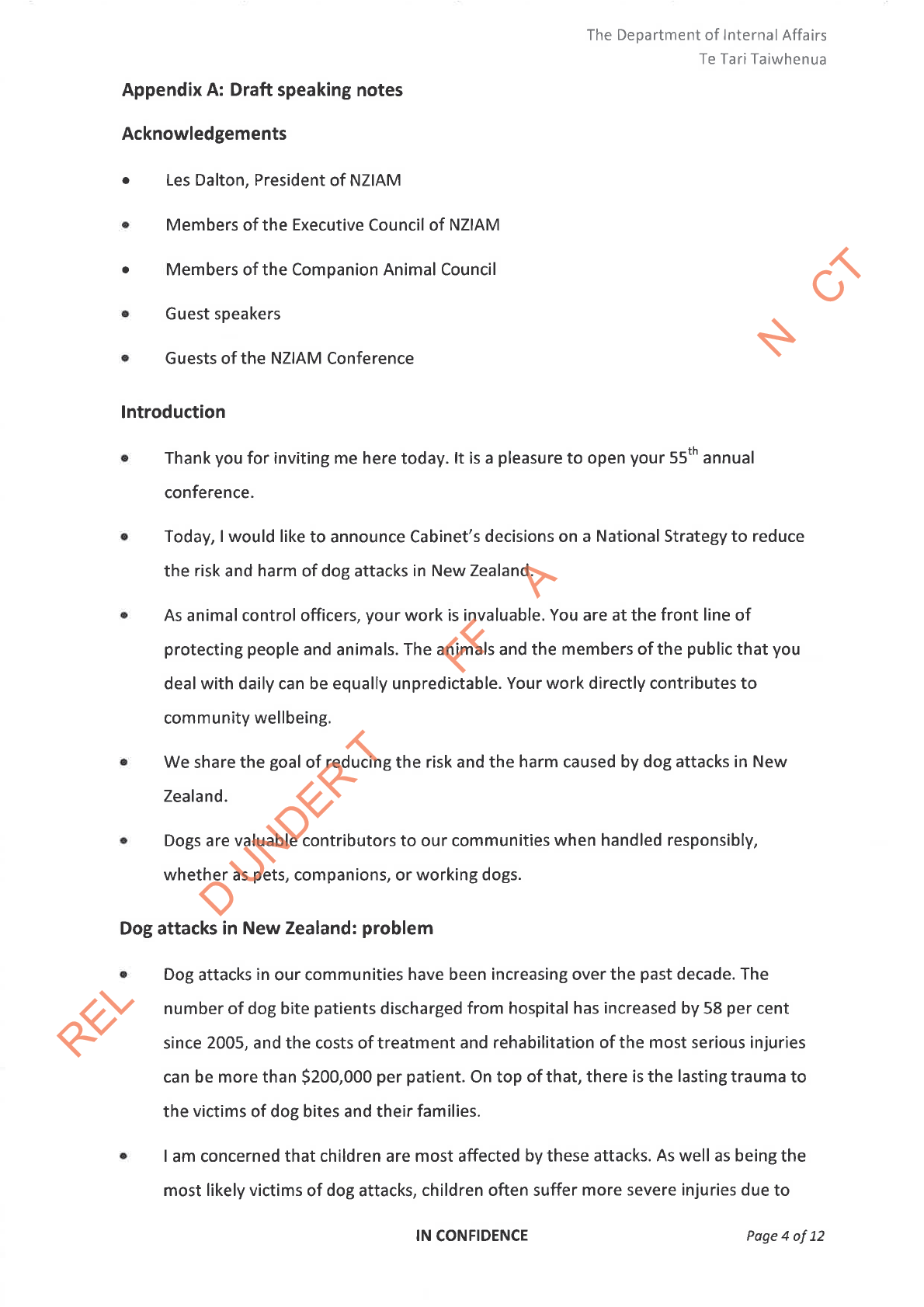
ACT
INFORMATION
RELEASED UNDER THE OFFICIAL

ACT
INFORMATION
RELEASED UNDER THE OFFICIAL
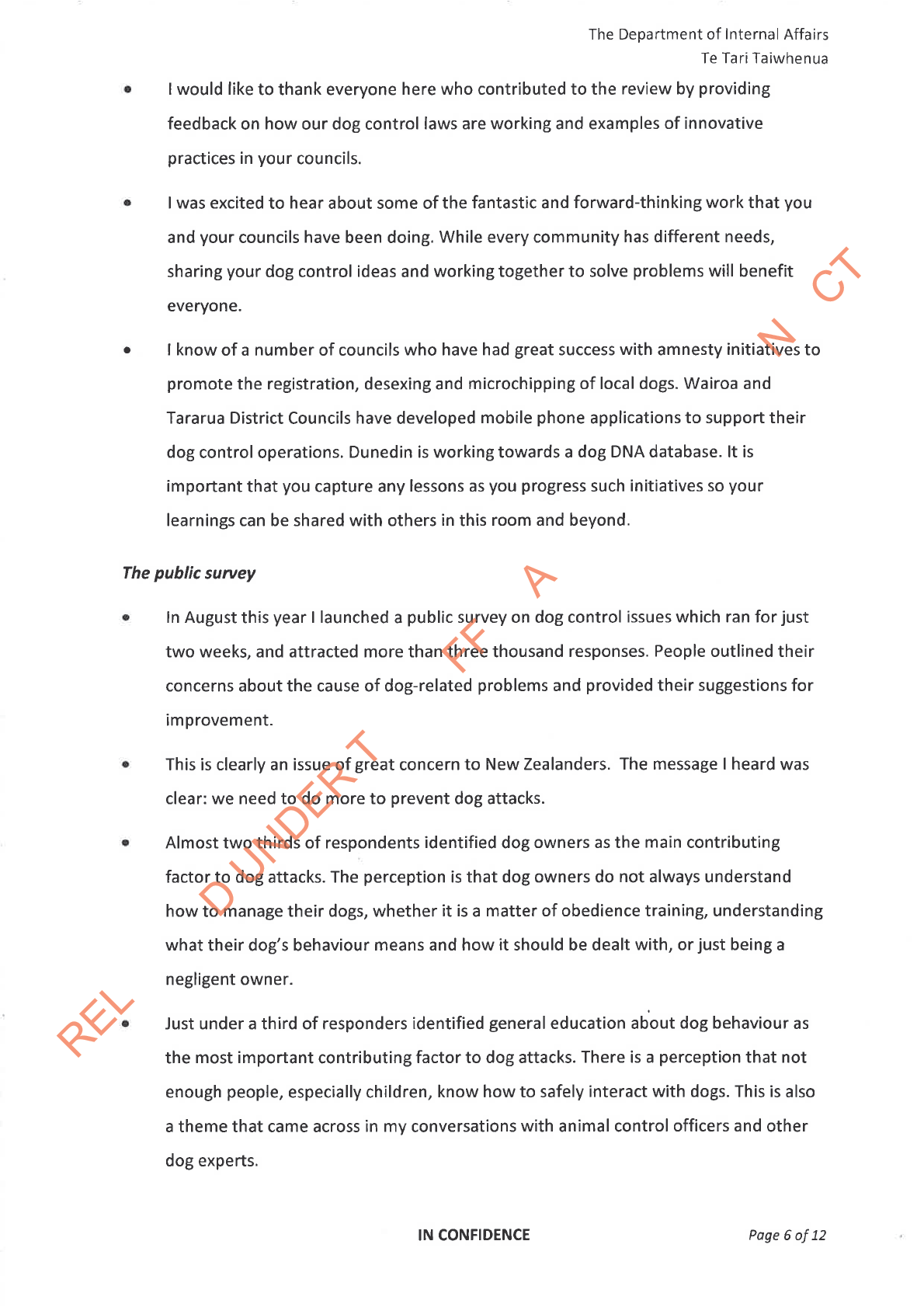
ACT
INFORMATION
RELEASED UNDER THE OFFICIAL
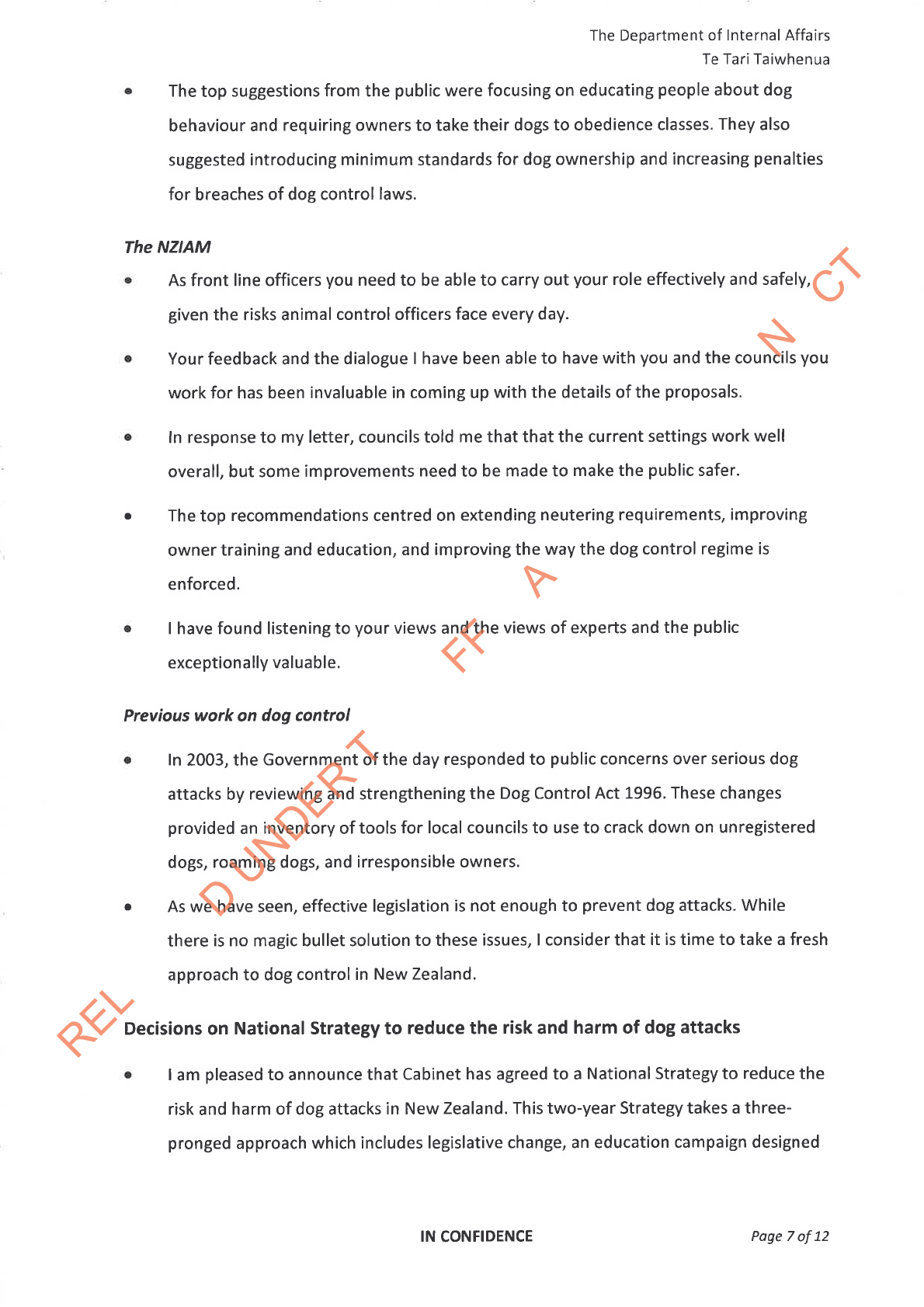
ACT
INFORMATION
RELEASED UNDER THE OFFICIAL
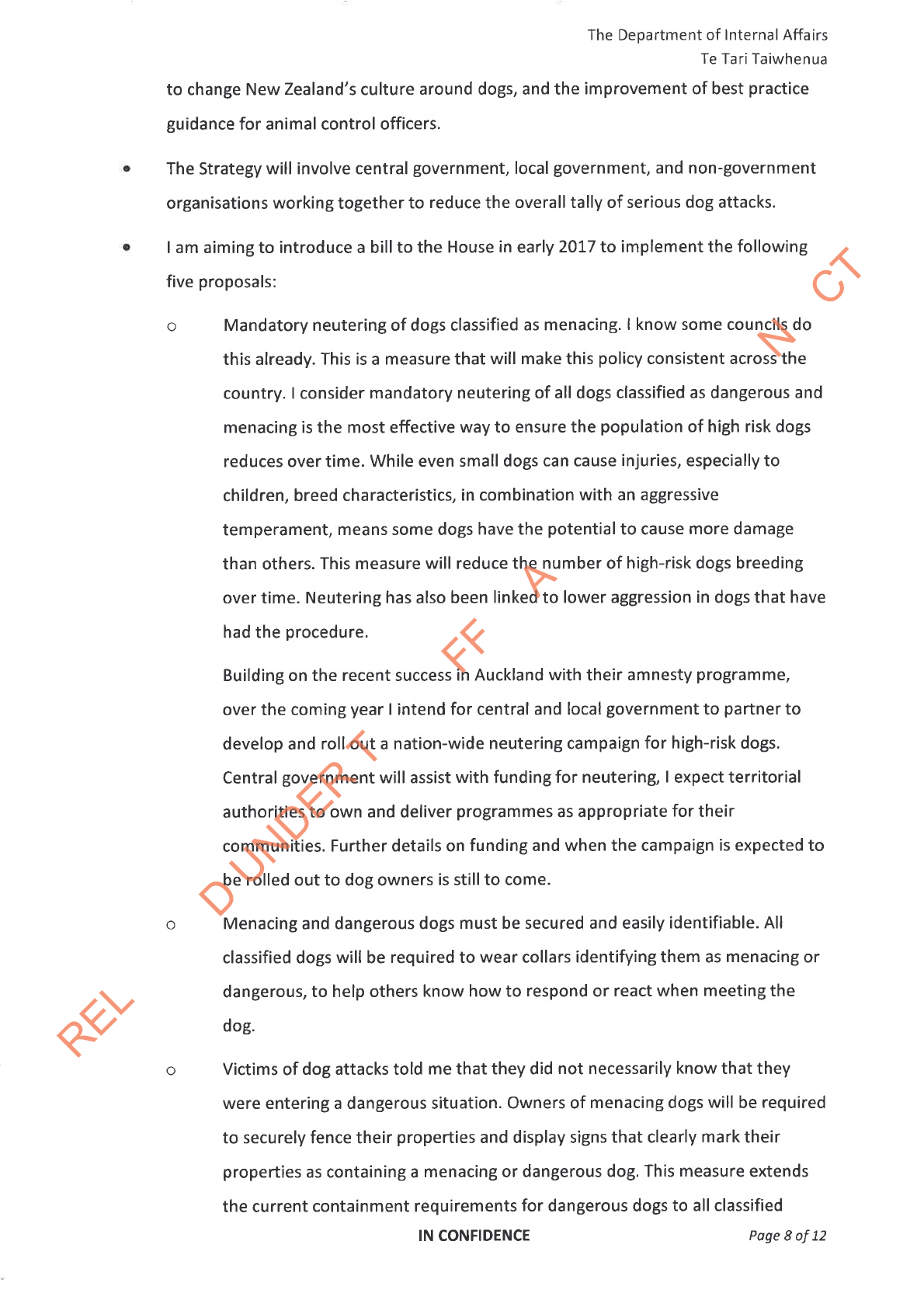
ACT
INFORMATION
RELEASED UNDER THE OFFICIAL
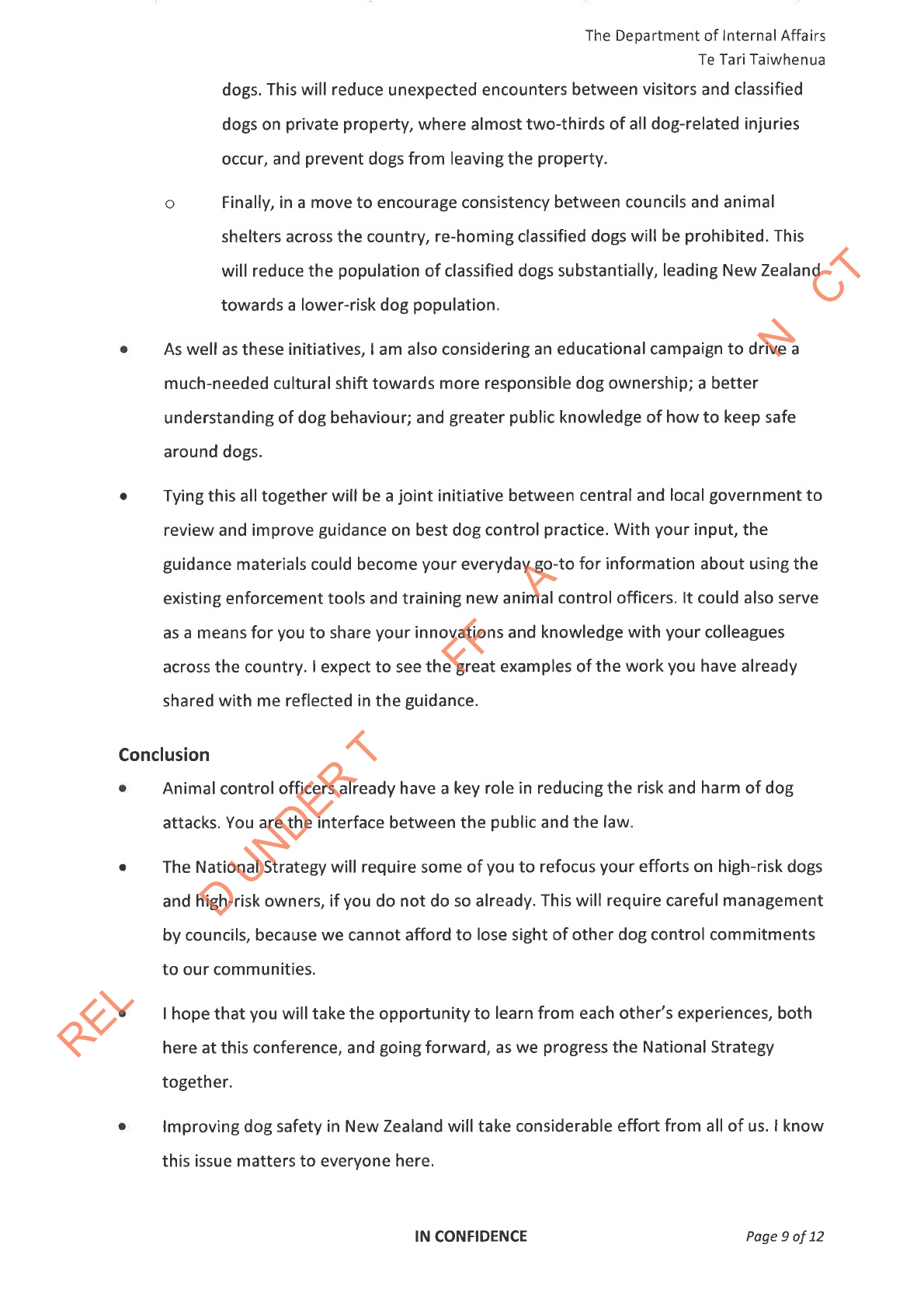
ACT
INFORMATION
RELEASED UNDER THE OFFICIAL
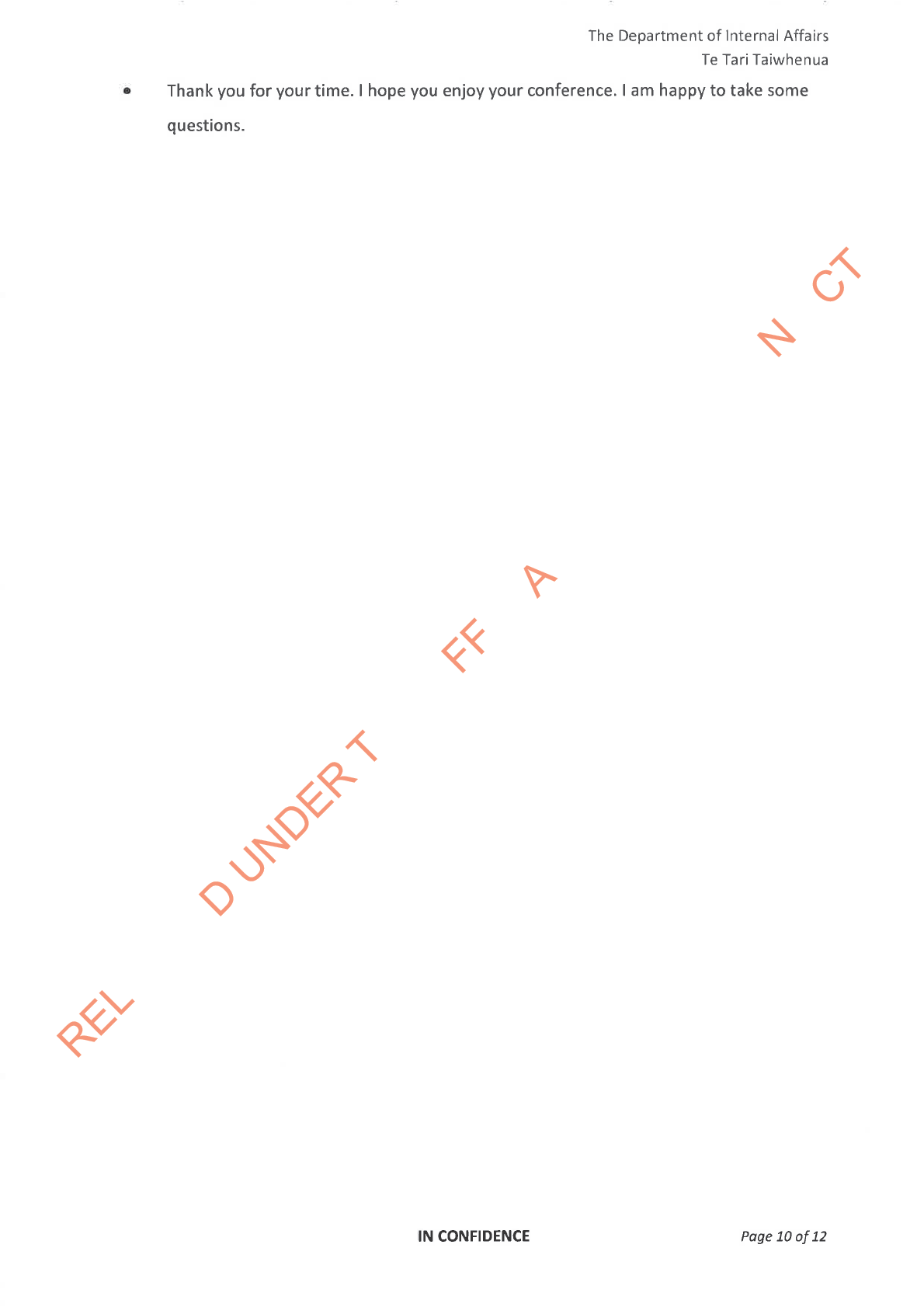
ACT
INFORMATION
RELEASED UNDER THE OFFICIAL

ACT
INFORMATION
RELEASED UNDER THE OFFICIAL

ACT
INFORMATION
RELEASED UNDER THE OFFICIAL
Document 33
DRAFT Questions and Answers – Dog Strategy
How much will this package cost?
The Government is contributing $0.85 million towards a neutering programme for menacing dogs.
Costs for other parts of the strategy are stil being established.
When wil these changes come into force?
The changes to the Dog Control Act 1996 are expected to come into force mid-late next year.
To what extent are children overrepresented in dog bite incidents?
ACT
Data from the University of Otago Injury Prevention Unit about dog-related incidents shows that
almost 30 per cent of patients from 2000 to 2014 were children under the age of ten.
What happens to the owners that don’t take up programme, for example wil the dogs be euthanized
and who covers this cost?
Under current proposed changes to the Dog Control Act 1996, all menacing dog w ll be required to
be neutered. The details of penalties for noncompliance are still being established.
What happens to dogs that aren’t rehomed?
Any dog that cannot be rehomed wil be humanely put down by an animal shelter.
INFORMATION
What is a dangerous dog?
Dangerous dogs include those where:
• the owner was convicted of an offence where the dog has rushed at a person or property,
causing injury or damage;
• the council believes the dog is a threat to public safety on the basis of sworn evidence; or
• the owner records in writing that it is a threat to public safety.
What is a menacing dog?
Menacing dogs include those that: THE OFFICIAL
• the council believes to pose a threat to public safety because of their behaviour or the
characteristics of the dog breed; and/or
• the council has reasonable grounds to believe belongs whol y or predominantly to one or more
of the breeds or types of dog listed in Schedule 4 of the Act. Currently these are the Dogo
Argentino, Brazilian Fila, Japanese Tosa and Perro de Presa Canario dog breeds and the American
Pit Bull Terrier dog type.
How many dangerous and menacing dogs are there in NZ?
There were 6,288 menacing dogs and 456 dangerous dogs registered with councils across New
Zealand in 2016.
Don’t these changes just target registered dogs? What is the government doing about unregistered
dogs?
RELEASED UNDER
RELEASED UNDER THE OFFICIAL
The neutering programme will incentivise a lot of dog owners to bring their dogs forward for
registration.
What are the current enforcement powers for unregistered dogs?
Anyone who fails to register their dog can be fined up to $3,000. The council may seize and impound
the dog.
Page 1 of 2
How many of the 6,288 already neutered?
Of the 6,288 registered menacing dogs in New Zealand in 2016, 4705 were neutered.
What will these collars look like?
The design of the new col ars has not been confirmed.
Will owners have to pay for the collars?
These details are not yet confirmed.
CT
Who will make these collars?
ACT
These details are not yet confirmed.
N
Who will administer the neutering programme?
Although the details have not yet been finalised, the neutering programme will be administered
locally. We are in discussions with Local Government New Zealand, the New Zealand Institute of
Animal Management, the Royal New Zealand Society for the Prevention of Cruelty to Animals, the
New Zealand Veterinary Association.
People who made submissions on New Zealand’s dog control laws highlighted that children do not
know how to safely interact with dogs and often misunderstand dogs’ behavioural signals – will this
strategy address educating children?
INFORMATION
The strategy includes a public education programme about responsible dog ownership and safety
around dogs. The details of this programme are still being finalised.
A
How will this strategy address “bad owners” if they don’t come forward or participate in the
strategy?
The neutering programme will incentivise a lot of dog owners to bring their dogs forward for
FF
registration. The Government is also reviewing the current penalties under the Dog Control Act
1996, and may consider changes to current penalties for noncompliance.
D UNDER T
REL
RELEASED UNDER THE OFFICIAL
Page 2 of 2







































